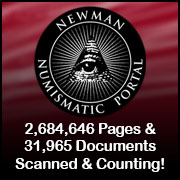
About UsThe Numismatic Bibliomania Society is a non-profit association devoted to the study and enjoyment of numismatic literature. For more information please see our web site at coinbooks.org SubscriptionsThose wishing to become new E-Sylum subscribers (or wishing to Unsubscribe) can go to the following web page link MembershipThere is a membership application available on the web site Membership Application To join, print the application and return it with your check to the address printed on the application. Print/Digital membership is $40 to addresses in the U.S., and $60 elsewhere. A digital-only membership is available for $25. For those without web access, write to: Charles Heck, Treasurer
AsylumFor Asylum mailing address changes and other membership questions, contact Chuck at this email address: treasurer@coinbooks.org SubmissionsTo submit items for publication in The E-Sylum, write to the Editor at this address: whomren@gmail.com BUY THE BOOK BEFORE THE COIN |
- WAYNE'S WORDS: THE E-SYLUM OCTOBER 30, 2019
- NEW BOOK: GUIDE BOOK OF U.S. TYPE COINS, 3RD ED.
- NEW BOOK: NUMISMATIC HISTORY OF PARAGUAY
- BANKNOTE DESIGNER ANDRZEJ HEIDRICH (1928-2019)
- NEWMAN PORTAL ADDS GERRY FORTIN DAILY BLOG
- FUTURE OF NUMISMATICS: WEAVER
- NOTES FROM E-SYLUM READERS: OCTOBER 27, 2019
- 2019 TOKEN CONGRESS REPORT
- CHERRYPICKERS' GUIDE DIE VARIETY PHOTOS SOUGHT
- WHITMAN 1940-1978 ALBUMS AND FOLDERS INFO SOUGHT
- VOCABULARY TERM: FINISH AND FINISHING, PART TWO
- WENDELL LEWIS PHINNEY (1884-1974)
- CHICAGO HALL OF FAME INDUCTS HARRY FLOWER
- HEADLESS SOLDIER MEDAL INFORMATION SOUGHT
- PAN SHOW FALL 2019 PHOTOS
- STEPHEN ALBUM 5TH INTERNET-ONLY AUCTION
- DUANE FEISEL TOKEN SALE CLOSING NOVEMBER 30, 2019
- JOHN W. ADAMS COMITIA AMERICANA MEDALS
- NUMISMATIC NUGGETS: OCTOBER 27, 2019
- THE ANCIENT COIN PETTING ZOO
- TWO FACES OF BEN FRANKLIN
- 1861 GOLD LIFE SAVING MEDAL
- LARGEST BANKNOTE COLLECTION IN THE WORLD?
- LOOSE CHANGE: OCTOBER 27, 2019
- THE 10 SCARIEST BANKNOTES OF ALL TIME
- FEATURED WEB PAGE: MODERN HALLOWEEN COINS
Click here to access the complete archive
To comment or submit articles, reply to whomren@gmail.com
Content presented in The E-Sylum is not necessarily researched or independently fact-checked, and views expressed do not necessarily represent those of the Numismatic Bibliomania Society.
WAYNE'S WORDS: THE E-SYLUM OCTOBER 30, 2019
 This week we open with two new books, an obituary, Newman Numismatic Portal updates and multiple notes from E-Sylum readers.
This week we open with two new books, an obituary, Newman Numismatic Portal updates and multiple notes from E-Sylum readers.
Other topics this week include the 2019 Token Congress, the Fall 2019 PAN Show, the Cherrypicker's Guide, dealer Wendell Phinney, collector Harry Flower, an 1861 gold lifesaving medal, and auction lots from Stephen Album, Duane Feisel and Stack's Bowers.
To learn more about U.S. Type coins, the numismatics of Paraguay, banknote designer Andrzej Heidrich, paperboy stories, Whitman coin albums and folders, patina finishes, Numismatist Editor Barbara Gregory, Oklahoma Territory tokens, Comitia Americana medals, the ancient coin petting zoo, the headless soldier medal, and the scariest banknotes of all time, read on. Have a great week, everyone!
Wayne Homren
Editor, The E-Sylum
NEW BOOK: GUIDE BOOK OF U.S. TYPE COINS, 3RD ED.
The latest edition of A Guide Book of United States Type Coins by Dave Bowers has been released. Whitman publisher Dennis Tucker submitted this article on the book's creation and explores how it developed over the years. Thanks! -Editor
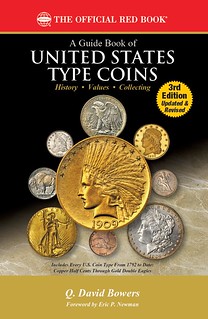 The first edition of the Guide Book of
United States Type Coins, by Q. David Bowers, was published in early 2005. Although the book was in many ways revolutionary, this wasn't the first time the broad panoply of
American coinage had been gathered into a single volume. A few predecessors include the following:
The first edition of the Guide Book of
United States Type Coins, by Q. David Bowers, was published in early 2005. Although the book was in many ways revolutionary, this wasn't the first time the broad panoply of
American coinage had been gathered into a single volume. A few predecessors include the following:
- Walter Breen's Complete Encyclopedia of U.S. and Colonial Coins, popularly known in the hobby simply as "Breen," was published in 1988.
- Before that, The History of United States Coinage as Illustrated by the Garrett Collection, also by Bowers, had debuted in 1979.
- And of course, the granddaddies of all hobby-oriented single-volume U.S. coin books had been published, more or less annually, since 1946 (the Guide Book of United States Coins, a retail price guide known as the "Red Book") and, before that, since 1942 (the Handbook of United States Coins, a wholesale guide called the "Blue Book").
So, this was not the first publication of every American coinage type in a single reference. But it was the first book to approach, specifically and with the hobbyist in mind, the subject of building a collection of U.S. "type coins"—that is, a grouping of specimens, each one carefully chosen to represent an entire design type. This is distinct from building a collection of every date and mintmark within those types.
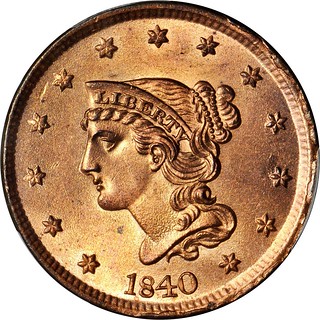
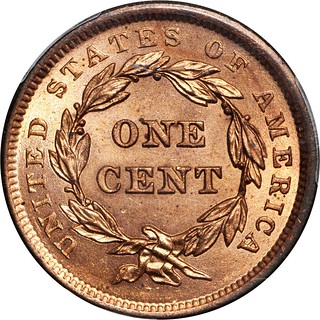
The Popularity of Collecting Coins by Type
Collecting U.S. coins by type has been popular for generations. "Such a pursuit is hardly new," Bowers would write years later in the foreword to Robert W. Shippee's Pleasure and Profit: 100 Lessons for Building and Selling a Collection of Rare Coins. "In fact, it is one of the most popular ways to collect."
Since the boom in U.S. coin folders and albums started in the 1930s, most major manufacturers have included "type set" holders in their product lines.
Collecting in this way gives a hobbyist well-defined goals. It is affordable. It also offers many ways to customize a personally meaningful collection. "Such a display would be a virtual panorama of American coinage from the earliest days to the present," as Bowers says. "Along the way, you would have specimens from each of the major engravers, examples of each denomination, and all of the different design variations. You could flip through the pages of any reference book and, upon seeing a picture of a type, say, ‘I have one of those!'"
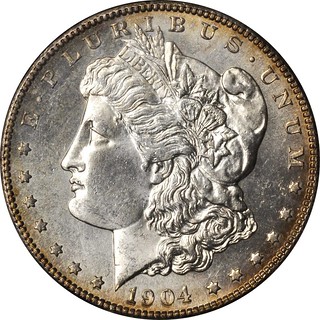
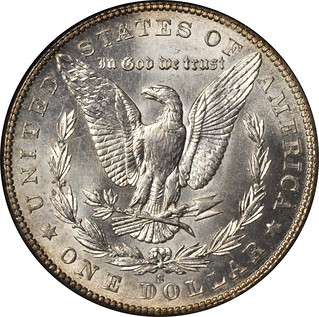
Creating the Guide Book
We billed the Guide Book of United States Type Coins as "A Complete History and Price Guide for the Collector and Investor." In true Bowers style, it was just that, with historical overviews of some 20 coin denominations, from copper half cents through gold double eagles; and advice on collecting the 100-plus coin types within those denominations. Bowers offered a lifetime career's worth of ideas, inspiration, and guidance on how to build a significant coin collection while learning a heck of a lot about American history and having fun along the way.
The process of organizing, writing, and editing the first edition of the Guide Book of United States Type Coins was an immersion in numismatic master-planning. This was one of the earliest books released in the modern renaissance of numismatic publishing that started around 2003, the year Dave Bowers took the role of numismatic director at Whitman Publishing. I joined the company as its publisher in 2004, and, together with Red Book editor Kenneth Bressett, valuations editor Jeff Garrett, Whitman senior editor Diana Plattner, and others, we carefully studied our flagship book (the Red Book) and its terminology, organization, and information architecture.
I remember well the many conversations we had on what constitutes a "type" versus a "subtype" or "variety." Nomenclature wasn't completely standardized within the hobby community. (It still isn't, today.) Was the Braided Hair large cent properly divided into the Young Head and Matron Head types? Was the half cent of 1840 to 1857 the Coronet type, or the Braided Hair type? Did Christian Gobrecht's nineteenth-century silver coins show "Seated Liberty" or "Liberty Seated"? Some writers referred to Franklin half dollars as the "Franklin Head" type. Should trade dollar be capitalized or not? Much of this terminology had long been standardized within the Red Book and the Blue Book, but Dave Bowers's study and classification of coin types for his new book revealed opportunities for clarification and, in some cases, change.
All of this discussion was very useful because we were also organizing a comprehensive new "Whitman Style Guide" to apply across the width and breadth of all the company's books, folders, albums, and other hobby products.
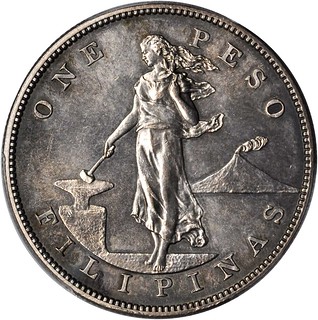
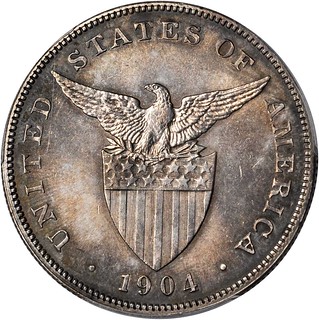
Launches, Updates, and Companions
We published the first edition of the Guide Book of United States Type Coins in January 2005, debuting it at the Florida United Numismatists convention held in Fort Lauderdale. It was a popular and critical success, selling briskly and earning the Numismatic Literary Guild's award for "Best Specialized Book on United States Coins."
The second edition followed in 2008, with updated market values, auction records, and certified-population data; improved photographs; cleaner typesetting; the addition of new coin types (Presidential dollars, Westward Journey nickels, and State quarters); a new section on "Great Collectors and Collections of the Past" (by Ron Guth and Jeff Garrett); new historical illustrations; a bibliography; and a bullion-value chart for determining the precious-metal values of common-date gold and silver coins.
In the meantime, Whitman published another book that addresses hobbyists' interest in the type-set approach to collecting. Ron Guth and Jeff Garrett wrote the beautifully illustrated coffee-table book United States Coinage: A Study by Type, which was also published in 2005. "One need not own a single cent to possess a wealth of knowledge about it," retired Louisiana congressman Jimmy Hayes observed in that book's foreword.
Robert W. Shippee's Pleasure and Profit debuted in 2014. Shippee, over the course of several years, had assembled a remarkable collection of about 150 U.S. coins by type, from half cents to double eagles. In his book he shared the lessons he learned along the way—lessons that came from costly mistakes as well as from profitable purchases. His collection sold for more than $1.5 million; his total gain after commissions, holding the coins for about 10 years, was nearly 40 percent. As you read Pleasure and Profit, though, you come to realize that his "profits" were far greater than just financial.
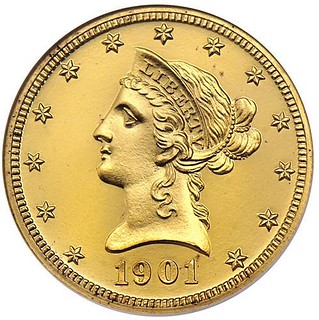
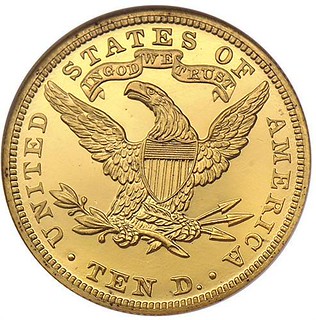
Type-Coin Collecting Today
Type-coin collecting is as popular as ever today. In an informal survey of 100 coin collectors in early 2019, I found that 15 percent had formed a "one of everything" type-coin collection, and almost as many had assembled the same collection except, more affordably, without gold coins. One out of every four had formed a nineteenth- or twentieth-century type set. Nearly 20 percent had built more than one kind of type set.
Respondents talked enthusiastically about their rainbow-toned dollar type sets, their slabbed type sets, Proof Barber types by denomination, and other personally significant collections.
Some mentioned the competitive registry sets maintained by PCGS and NGC, which have thousands of active participants in their "Type Set" categories. (In April 2019 PCGS had 10,427 type sets registered, and NGC had 5,713. Categories include complete sets of U.S. circulation-strike coins; nineteenth- and twentieth-century Proof types; first-year-of-issue type sets; and many others—more than 100 different ways to form a type collection by design, era, denomination, mint, and other classifications.)
85 percent of the collectors I polled had completed or at least started a collection of U.S. coins by type.
For these enthusiasts and thousands of others actively collecting in 2019 and beyond, we've updated the entirety of the Guide Book of United States Type Coins in a substantially revised third edition.
- The book has been expanded from 288 pages to 320 pages.
- The entire volume has been reformatted to make it easier to read and navigate.
- Market values have been updated to provide a snapshot of the financial side of forming a type-coin collection.
- The historical price charts, too, have been updated, showing the paths, up and down, of each coin type over the past 70-plus years.
- We've incorporated the latest numismatic research, modified some of the older editions' categories and chapters, and included the most recent new coin designs.
- We've also added a new appendix on Philippine coins struck under U.S. sovereignty, which can easily be collected by type and which form an attractive and historically important section of American coinage.
It might be said that a numismatic author starts a book when he writes his manuscript, but his readers finish it when they build their collections. I believe the third edition of the Guide Book of United States Type Coins will inspire many collectors to join with Dave Bowers in creating their own unique chapters—their type-coin collections—in this engaging hobby pursuit.
Whitman publisher Dennis Tucker is an award-winning researcher who has written and lectured nationwide on coins, medals, and other antiques and collectibles. A collector since the age of seven, he is a Life Member of the American Numismatic Association, a past governor of the Token and Medal Society, and the numismatic specialist on the Treasury Department's Citizens Coinage Advisory Committee.
A Guide Book of United States Type Coins, 3rd edition
By Q. David Bowers; foreword Eric P. Newman
ISBN 079484636X
Softcover, 6 x 9 inches
320 pages
Full color
Retail $19.95 U.S.
https://www.whitman.com/store/Inventory/Detail/Guide-Book-of-U-S--Type-Coins-3rd-Edition+079484636X
NEW BOOK: NUMISMATIC HISTORY OF PARAGUAY
A new digital edition of Raúl Olazar's book on the numismatic history of Paraguay (Historia Monetaria Y Numismática del Paraguay ) has been published. Raúl reports that the first edition of the book published in physical form in 2017 is now sold out. This new digital presentation has the same content and is available on several platforms. Here's a Google-translated description. -Editor
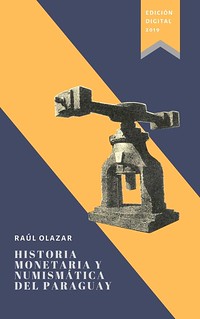 Numismatic
and monetary history of Paraguay is a work that seeks to spread Paraguayan history through numismatics itself, which today in the country lacks any type of support and is
often unknown to people. It seeks to provide the reader with the basic and necessary information about Paraguayan numismatics as well as some of the national monetary history from
its beginnings to the present day.
Numismatic
and monetary history of Paraguay is a work that seeks to spread Paraguayan history through numismatics itself, which today in the country lacks any type of support and is
often unknown to people. It seeks to provide the reader with the basic and necessary information about Paraguayan numismatics as well as some of the national monetary history from
its beginnings to the present day.
Various issues make up this work, starting from the beginning in the monetary system, following the processes until we have our own national coin, going through the various changes suffered to become the currency we know today and which is recognized as the most stable in the region.
For more information, or to order, see:
Historia monetaria y numismática del Paraguay (https://gum.co/hnymp)
Historia monetaria y numismática del Paraguay (Spanish
Edition) (https://www.amazon.com/Historia-monetaria-numism%C3%A1tica-Paraguay-Spanish-ebook/dp/B07YL62346/ref=sr_1_fkmr0_1)
https://books.apple.com…/historia-monetaria-y…/id1481903918

BANKNOTE DESIGNER ANDRZEJ HEIDRICH (1928-2019)
Polish banknote designer Andrzej Heidrich has died. Here's a report from Warsaw published October 26, 2019. -Editor
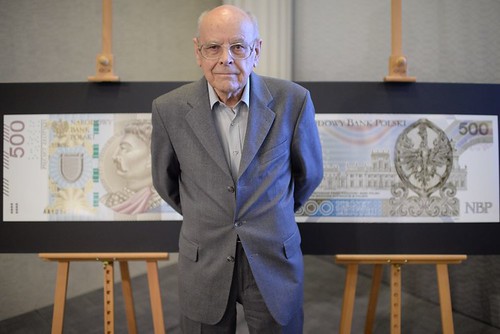
Many Poles had never heard of Andrzej Heidrich, but his designs are everywhere: on the banknotes people carry in their wallets and use every day. After a long and productive career, the Polish graphic artist and illustrator passed away on October 20, at the age of 90.
Heidrich was born in Warsaw in 1928 and studied at the Graphics Department of the city's Academy of Fine Arts, graduating with a distinction.
In 1960, the National Bank of Poland invited him to start working with it. The first banknote designed by him was a 500 zloty from 1974 portraying military leader Tadeusz Kosciuszko, with a high collar and flowing curls.
Looking back over fifty years later, Heidrich expressed his satisfaction with that first banknote.
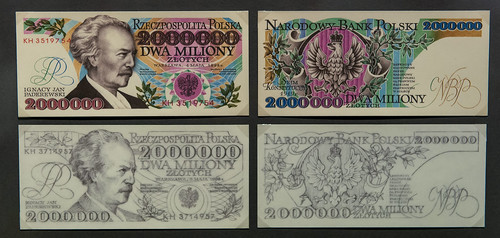
"It was a great experience for me when my first banknote entered circulation," he told RMF24 radio in an interview in 2016. "I always feared how it would be received by society, whether there would be any comments. It seems to me that it was well received by society."
Over the course of his long career, Heidrich designed the banknotes in the "Great Poles" series, used between 1975 and 1996, and then the "Kings and Princes of Poland" ones, which have been used in Poland since 1995.
He also designed stamps for the Polish Post Office and other widely-recognised symbols, including the current form of the white eagle on Poland's crest of arms and the eagles on the caps of Polish soldiers' uniforms.
Heidrich received various state honours for his work. He will be buried at Powazki Cemetary in Warsaw.
To read the complete article, see:
Bank note designer passes away after life of notable
achievement (https://www.thefirstnews.com/article/bank-note-designer-passes-away-after-life-of-notable-achievement-8313)
NEWMAN PORTAL ADDS GERRY FORTIN DAILY BLOG
The latest addition to the Newman Numismatic Portal is the Gerry Fortin Rare Coins Daily Blog. Project Coordinator Len Augsburger provided the following report. -Editor
Newman Numismatic Portal Adds Gerry Fortin Rare Coins Daily Blog
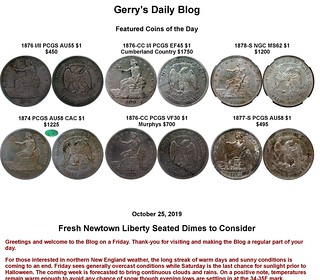 Recently added to the Newman Portal is
the Daily Blog from Gerry Fortin Rare Coins (GFRC). After retiring from the semiconductor industry, Fortin launched GFRC in 2014 as a specialty dealer of Bust, Liberty
Seated, and U.S. gold coinage. Fortin challenged himself to create fresh content on a daily basis, and the result today is essentially the business diary of a specialized,
Internet-based coin dealer.
Recently added to the Newman Portal is
the Daily Blog from Gerry Fortin Rare Coins (GFRC). After retiring from the semiconductor industry, Fortin launched GFRC in 2014 as a specialty dealer of Bust, Liberty
Seated, and U.S. gold coinage. Fortin challenged himself to create fresh content on a daily basis, and the result today is essentially the business diary of a specialized,
Internet-based coin dealer.
Today's culture is less formal than that of fifty years ago, and the ubiquity of information has created an expectation of transparency. Professional secrets, once closely guarded by practitioners of any specific craft, are fewer are far between, and the occupational mysteries of nearly any profession can be uncovered with a simple Google query. Fortin embraces all of this and opens his business to daily scrutiny – consignments come in, clients are served, and the challenges of travel, IT, photography, accounting, and inventory control are on full view to the reader. Given such an approach, it is no surprise that Fortin agreed to contribute his archive to the Newman Portal repository. This is a unique view of a particular coin business in a numismatic market that is becoming more and more defined by the Internet Age.
Link to Gerry Fortin Rare Coins Daily Blog archive on Newman Portal:
https://nnp.wustl.edu/library/publisherdetail/534276
Link to Daily Blog on Gerry Fortin Rare Coins site:
http://www.seateddimevarieties.com/DailyBlog.htm
FUTURE OF NUMISMATICS: WEAVER
These are selections from the David Lisot Video Library that feature news and personalities from the world of coin collecting. David has been attending coin conventions since
1972 and began videotaping in 1985. The Newman Numismatic Portal now lists all David's videos on their website at:
https://nnp.wustl.edu/library/multimediadetail/522852
Here's one from the ANA Future of Numismatics Symposium. -Editor
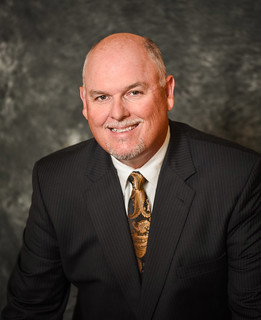 Future of Numismatics Symposium: Richard Weaver
Future of Numismatics Symposium: Richard Weaver
An excerpt of the video is available for viewing on the Coin Television YouTube Channel at:
https://youtu.be/RVW5wG4WFpE
This video is a highlight from Future of Numismatics Symposium: What the Future May Hold
Donn Pearlman, Moderator, David Lisot, Video Producer, CoinTelevision.com. At the 2019 World's Fair of Money the American Numismatic Association asked some of the coin industry's most influential leaders about what they believe is in store for the future of the hobby. Hear these titans of numismatics share what they believe the future holds.

NOTES FROM E-SYLUM READERS: OCTOBER 27, 2019
The Constitution and 'In God We Trust'
Ben Weiss writes:
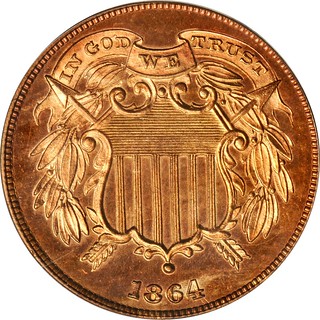 In his review of the book by Bill Bierly "In God We
Trust", Dave Bowers writes: "Today there are vocal critics who feel that it [i.e. In God We Trust] has no place on coins or paper currency." In fact, among those critics are our
very Founding Fathers who wrote in the First Amendment to our United States Constitution, ratified in 1791, that "Congress shall make no law respecting an establishment of
religion, or prohibiting the free exercise thereof;...". I don't think many people would argue that "God" isn't a religious concept. Therefore, placing "God" on our official coins
or paper currency does indeed respect the establishment of religion, which is specifically proscribed in our Constitution.
In his review of the book by Bill Bierly "In God We
Trust", Dave Bowers writes: "Today there are vocal critics who feel that it [i.e. In God We Trust] has no place on coins or paper currency." In fact, among those critics are our
very Founding Fathers who wrote in the First Amendment to our United States Constitution, ratified in 1791, that "Congress shall make no law respecting an establishment of
religion, or prohibiting the free exercise thereof;...". I don't think many people would argue that "God" isn't a religious concept. Therefore, placing "God" on our official coins
or paper currency does indeed respect the establishment of religion, which is specifically proscribed in our Constitution.
As a related issue, Article VI of our Constitution states that "...no religious Test shall ever be required as a Qualification to any Office or public Trust under the United States." So people can believe whatever they wish, but as citizens we are bound to obey the tenants of the most important legal document we have.
One of my first coin show purchases as a young collector was a two-cent piece for my type collection. As a longtime collector of U.S. coins it's hard to imagine NOT having that motto around. The issue rears its head periodically and so far the legal challenges have been unsuccessful. I imagine someday it might actually find its way back to the Supreme Court for a decision. The final chapter on 'In God We Trust' may not have been written yet. But I'm eagerly looking forward to getting my copy of Bill's book to learn more about the origins of this familiar phrase on our money. -Editor
To read the Wikipedia entry, see:
In God We Trust (https://en.wikipedia.org/wiki/In_God_We_Trust)
To read the earlier E-Sylum article, see:
BOOK REVIEW: IN GOD WE TRUST (https://www.coinbooks.org/v22/esylum_v22n42a07.html)
Fact-Checking the Stella-Bordello Connection
Eric Schena submitted these notes on the purported use of $4 Stella coins as jewelry by Washington, D.C. madams. -Editor
I saw the note regarding the $4 Stella Stack's Bowers Galleries has in the November Baltimore auction and thought I would drop a note since I wrote the historical description for that coin. I had heard about the purported brothel connection for decades ever since I first saw reference to it in Breen's encyclopedia. Sure enough, just checked my copy:
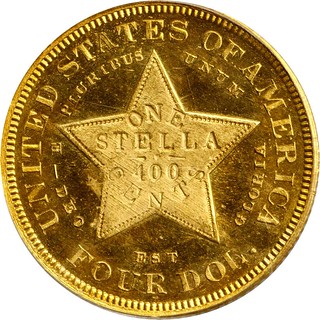 "Though extremely popular today, and much
exaggerated in rarity, Stellas in their own day provided a juicy scandal resulting in amusing newspaper copy for several years - and many laughs at the expense of the congressmen
who had ordered the restrikes. The story broke that while no coin collector could obtain a Stella from the Mint Bureau at any price, looped specimens commonly adorned the bosoms
of Washington's most famous madams, who owned the bordellos favored by those same congressmen. Today there are several dozen 1879 Flowing Hair Stellas with telltale traces of
removal of those same loops, whose owners probably sometimes wish the coins could talk."
"Though extremely popular today, and much
exaggerated in rarity, Stellas in their own day provided a juicy scandal resulting in amusing newspaper copy for several years - and many laughs at the expense of the congressmen
who had ordered the restrikes. The story broke that while no coin collector could obtain a Stella from the Mint Bureau at any price, looped specimens commonly adorned the bosoms
of Washington's most famous madams, who owned the bordellos favored by those same congressmen. Today there are several dozen 1879 Flowing Hair Stellas with telltale traces of
removal of those same loops, whose owners probably sometimes wish the coins could talk."
He even includes this note under #6408:
"More than half the survivors show traces of cleaning or improper handling; many are frankly impaired; several dozen show solder residues from earlier use as jewelry (see introductory text), but their scandalous history keeps them in demand."
Unfortunately, Breen makes no specific citations for the original newspaper stories and I couldn't find any such references in contemporary news accounts other than a few banal announcements of new bills authorizing the coins in Congress. Considering his sometimes rather questionable/exaggerated scholarship and the lack of reference to primary source materials, I chalked it up to artistic license or recounting a second- and third-hand story, so I have studiously avoided stating that story as fact. Makes for great copy but poor scholarship.
There are certainly many impaired examples - I actually cataloged such an example in an earlier sale. The coin is a great candidate for jewelry: not too large and not too small, plus I can see how the large star makes it particularly appealing for that purpose. Interesting stuff and hopefully someday we can get to the source of that story.
Thanks. It does make a great story, but it may only be that, at least until some contemporary documentation shows up. -Editor
To read the earlier E-Sylum article, see:
HOW THE $4 STELLAS CAME TO BE (https://www.coinbooks.org/v22/esylum_v22n42a21.html)
Was Charles Ira Bushnell really an Uncle of the Chapman Brothers?
Julia Casey writes:
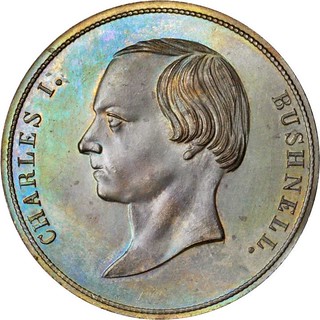 "Recently I was researching the Fugio "New
Haven" restrikes and "Bushnell Fantasy" Fugios for a new article (with Christopher McDowell) which will be published in the December issue of the Journal of Early American
Numismatics (JEAN). More than once I came across references to Bushnell being an uncle to Samuel Hudson Chapman and Henry Chapman. This relationship was implied to be why the
Chapmans may have obtained the consignment of the Bushnell collection for their famed sale of 1882.
"Recently I was researching the Fugio "New
Haven" restrikes and "Bushnell Fantasy" Fugios for a new article (with Christopher McDowell) which will be published in the December issue of the Journal of Early American
Numismatics (JEAN). More than once I came across references to Bushnell being an uncle to Samuel Hudson Chapman and Henry Chapman. This relationship was implied to be why the
Chapmans may have obtained the consignment of the Bushnell collection for their famed sale of 1882.
"I decided to look into the genealogy of Bushnell and the Chapman brothers but could not find the connection. The Chapmans' parents were both said to be from Ireland and Bushnell was from an old New England family. I also attempted to look into Bushnell's wife and the Chapmans' wives but was not able to place the relationship. Can any readers provide additional information? "
Another long-repeated "fact" that may or may not be true. Can anyone point to some evidence for this? Has the topic been researched before?
According to Pete Smith's American Numismatic Biographies, "After his death his son offered the coin collection for sale at $10,000. Lorin Parmelee bought it for about $8,000. After skimming the collection, the remainders were consigned to the Chapmans for auction June 20-24, 1882."
Had there been a prior family relationship I suspect the Bushnell collection would have gone directly to the Chapmans. Did a family connection materialize later? -Editor
Pete Smith adds:
"Charles Ira Bushnell was the only child of Giles and Ann Bushnell. Samuel Hudson Chapman and Henry Chapman were sons of Henry Chapman, Sr. and Jane Hudson Chapman. I have not found names of their brothers and sisters. At the moment I cannot confirm that Bushnell was an uncle of the Chapmans."
To read the Bushnell ANB bio entry on the Newman Numismatic Portal, see:
Charles Ira Bushnell (https://nnp.wustl.edu/Library/PersonDetail/380)
More Paperboy Collecting Stories
Paul Peelle of Amherst, MA submitted this story of his paperboy experiences. Thanks! -Editor
I just read "Paperboy Collecting Lessons" in the 9 October edition of The E-Sylum. Here is my story:
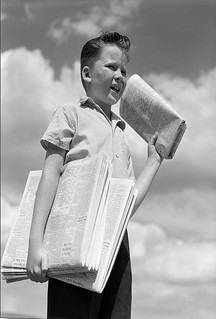 I had some newspaper routes beginning in the
late '50s through the mid-'60s on Long Island in NY. Not surprisingly, I collected one-cent pieces. I never found a single Indian Head penny or those half dozen or so key
Lincoln dates. Nonetheless, I enjoyed searching.
I had some newspaper routes beginning in the
late '50s through the mid-'60s on Long Island in NY. Not surprisingly, I collected one-cent pieces. I never found a single Indian Head penny or those half dozen or so key
Lincoln dates. Nonetheless, I enjoyed searching.
I lived in a very hilly area and had one customer who lived on a very steep hill. She always appreciated that I got her newspaper delivered to her front door nice and dry, even on days with such heavy snow that no car could make it up that hill (I left my bicycle at the bottom of the hill and walked up). Six days of delivery cost thirty cents; a few customers might give me an extra five-cent tip. This old-to-me woman, however, would give me a half dollar every Saturday. Almost always it was a Walking Liberty; otherwise it was a Franklin. Saving pennies for a collection was affordable; even though it was strain, I did put aside those Walkers—I really liked the design. No, I never received any 1921s. Duplicates and Franklins went into the bank, along with all of my other earnings. Between that and the money I earned from shoveling snow (no snow-throwers in those days!), I had enough to pay for my first year of college!
But there is more. Since all I could afford to collect were the pennies and halves, I never looked at other coins that went through my hands before the bank. On one Saturday (collection day), my eye happened to be caught by this one particular five-cent piece. I could clearly see the S mint mark below the buffalo on the plain, and then flipping it over saw the bold 1913 date. I don't know why, but I decided to look it up in my Red Book. It had a value of $35. What should I do? I don't collect nickels. Maybe I could sell it, but I don't know how. I should probably just put it in the bank as usual. As I held it, I fell victim to the beauty of James Earle Fraser's design. And thus I expanded my collection to include Indian Head nickels. I eventually picked up the attractive Standing Liberty quarter dollars since it was a short series (with lots of holes).
My paper carrier career afforded me the opportunity to search through a reasonable amount of change (without roll searching from banks) and build a relatively nice, strictly pocket-change collection. Thank you Long Island Press.
Thanks - great story. I remember one Friday I was walking my route collecting payments. As I rang a doorbell a dog walked up on the porch beside me. The lady opened the door and the dog ran in. Before I could tell her how much she owed, she began yelling "Get your dog out of my house!!" MY dog?? I thought it was YOUR dog!! I went inside and chased it out for her.
I started delivering around 1969 and while I did get some silver coins I don't recall ever getting any Walking Liberty or Franklin Halves, just Kennedys. To make paying my route manager easier I would take my change to a local store and they were happy to exchange the coins for bills. They would also save silver coins for me, which I bought at face value. Those were the days. -Editor
To read the earlier E-Sylum article, see:
PAPERBOY COLLECTING LESSONS (https://www.coinbooks.org/v22/esylum_v22n40a30.html)
Wife's Coin Collection Plan
John Regitko of Toronto, Canada writes:
My wife has an evacuation plan for my coin collection if I pass on before her. It can be summed up in one word:
"Coinstar"
Ouch! Does the machine spit out the empty slabs? -Editor
To read the earlier E-Sylum article, see:
WHAT'S YOUR COLLECTION EVACUATION PLAN? (https://www.coinbooks.org/v22/esylum_v22n42a24.html)
2019 TOKEN CONGRESS REPORT
Jeff Rock provided this great report on the recent Token Congress in Warwick, England. Thank you! -Editor
Have you ever wanted to go to Congress? In the current political climate, probably not. But how about a numismatic congress? Early in October the 38th annual Token Congress in England was attended by well over 100 collectors interested in tokens. The talks were mainly on British tokens ranging from the 16th to the 20th centuries, with most on the 17th to 19th century, but also included a talk on token literature; past years have featured talks on both Canadian and American tokens as well as other world issues. The talks can range from under 10 minutes to an hour, with most comfortably in the 20-45 minute range. While most Americans have never heard of this event (there were slightly over a half dozen of us in attendance this year), it is such an enjoyable experience that it is worth sharing with E-Sylum readers, and perhaps a few more of you will venture over next year.
The first thing to note is that the Congress is run completely by volunteers, that it changes locale every year, and that it is held a few days after major auctions of tokens are (usually) held in London, and the week after London's largest coin show, Coinex. In some of the earlier years the Congress traveled further afield, with some held in Wales and Scotland. In recent years the sites have stayed within an hour or so train travel from London which makes them easy to get to, mostly in the towns of Warwick (this year's site) and Northampton (where it will be next year). The event can best be described as "total token immersion." During the Congress weekend you meet at the host hotel on Friday afternoon, and you leave on Sunday afternoon. There is a great deal of camaraderie, a great deal of fun – and a great deal of food and drink as well.
Friday night has a nice buffet dinner and then the auction – with lots consigned by members; the prices on these are usually quite fair compared to prices realized at major auction houses, and there have been some very interesting things up for bidding over the years. After the auction there is socializing and beer – the firm of Baldwin's generously providing several kegs of local brew to sustain the attendees throughout the course of the weekend.
Saturday you are up bright and early for a full day, with breakfast and then the start of talks. This year there were four talks followed by a break for tea and coffee, a few more talks then a break for lunch, three more talks and another tea break (it is England after all), and then three more talks before the gala dinner (with wine provided by the auction firm Dix, Noonan Webb), the whole evening capped off by the bourse – anyone can get a table for a very modest fee, and there are usually over a dozen dealers and collectors set up, offering literally thousands of different tokens from a few Pounds on up to thousands of Pounds apiece. The bourse lasts until midnight – and there were people still in the room up to that time and beyond!
Somehow you manage to still get up early on Sunday for breakfast, have five talks before tea, and an equal number after, and finally parting ways, looking forward to doing it all again the following year. While many attendees have been coming for decades, others are first-timers, and all are made to feel welcome since there is a shared passion.
We simply have nothing like this in American numismatics. It is different from the traditional coin show that is centered around the bourse, with (maybe) a few talks taking place in rooms far away from the show itself. The Token Congress is an entire weekend centered around education, camaraderie and fun, and offers a chance to add something both to your collection and your knowledge base.
Next year's event will be held October 2-4th in Northampton, and for £200 (as of this writing about $260) you get two nights in a Hilton hotel, all meals for your stay (two breakfasts, two dinners, three tea and coffee breaks and a lunch), and access to all the talks, auction and bourse. It is simply one of the best bargains around, in all of numismatics.
It can easily be combined with a British or European holiday at what is one of the best times of year to travel – summer is over, the weather is a bit cooler, kids are back in school and air and hotel prices are low. If you want to sign up or learn more about the 2020 Token Congress, please contact John Newman at: johnnewman1@sky.com. And if you are a collector with something interesting to share – why not think about giving a talk too?
Jeff provided these photos, too. Thanks! -Editor
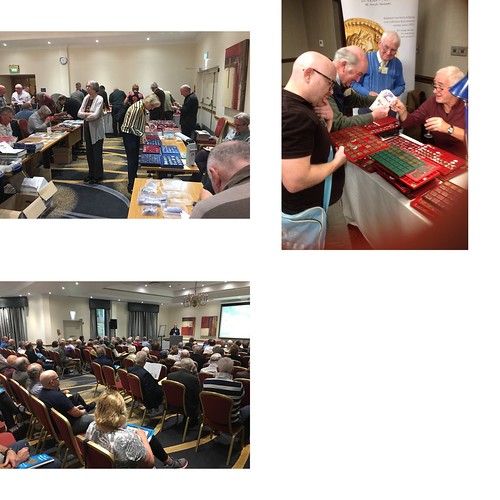
The Bourse, and a talk
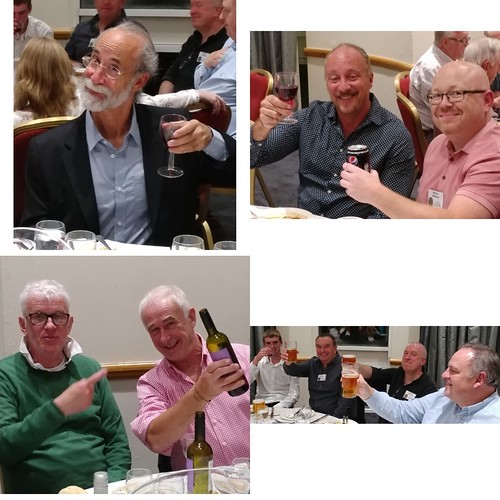
The beer, wine and a Pepsi too.
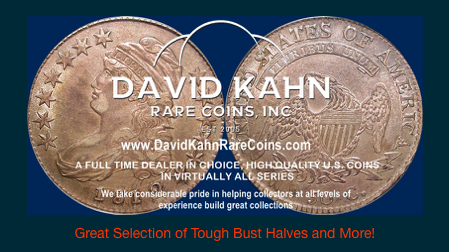
CHERRYPICKERS' GUIDE DIE VARIETY PHOTOS SOUGHT
Dennis Tucker of Whitman Publishing forwarded this press release seeking photographs of die varieties of U.S. coins for consideration in the next edition of the Cherrypickers' Guide. This first image shows coauthor Larry Briggs. Can anyone help? -Editor
Cherrypickers' Guide, Sixth Edition, Volume II
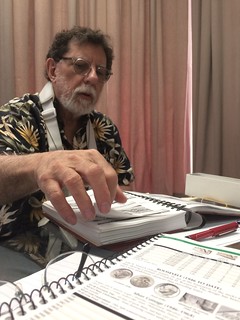 Whitman Publishing is calling on
the hobby community for photographs of die varieties of U.S. coins from half dimes to gold double eagles, plus commemoratives and bullion coins. These denominations and coin types
will be covered in the sixth edition, volume II, of the Cherrypickers' Guide to Rare Die Varieties of United States Coins. The new book will be published in 2020, marking
the 30th anniversary of the popular numismatic reference.
Whitman Publishing is calling on
the hobby community for photographs of die varieties of U.S. coins from half dimes to gold double eagles, plus commemoratives and bullion coins. These denominations and coin types
will be covered in the sixth edition, volume II, of the Cherrypickers' Guide to Rare Die Varieties of United States Coins. The new book will be published in 2020, marking
the 30th anniversary of the popular numismatic reference.
To "cherrypick" is to examine coins that appear normal at first glance, seeking ones with unusual characteristics—overdates, repunched mintmarks, doubled and tripled dies, and similar features—that reveal them to be rare and valuable. The Cherrypickers' Guide uses close-up photographs and text descriptions to guide collectors in what to look for. It includes rarity ratings and retail values.
Cherrypickers' Guide coauthor Bill Fivaz and professional numismatist Larry Briggs are coordinating edits and updates for the new volume. Along with Whitman staff, they held an editorial summit in Chattanooga, Tennessee, in May 2019. They meet regularly to plan the book's contents.
"We're expecting the new volume to include more than 800 die varieties, including many new additions," said Fivaz. It will cover Capped Bust coinage from half dimes through half dollars; Liberty Seated coinage; Barber silver coins; and every modern series from the early 1900s to date, plus gold dollars through $20 gold coins, classic commemoratives, and modern bullion pieces.
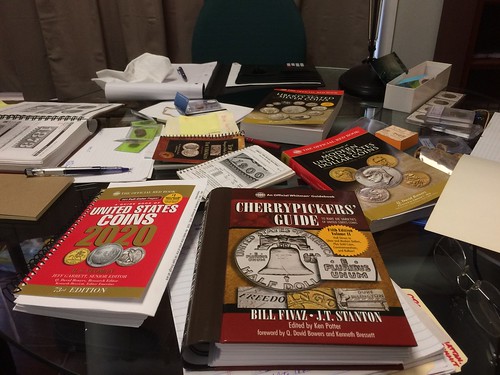
Research materials at the May 2019
Cherrypickers' Guide editorial summit in Chattanooga
"Many coin series are being expanded, and we'll have a few entirely new sections," said Whitman publisher Dennis Tucker. "This volume includes some of the most popular U.S. coin types, including Mercury and Roosevelt dimes, Washington quarters, Liberty Walking half dollars, Franklin and Kennedy half dollars, Morgan and Peace silver dollars, and modern dollar coins."
The book's editors have reached out to the hobby community for advice, recommendations, and research. Collectors and dealers who have photographs to share may contact the Cherrypickers' Guide team by email at cherrypickers@whitman.com .
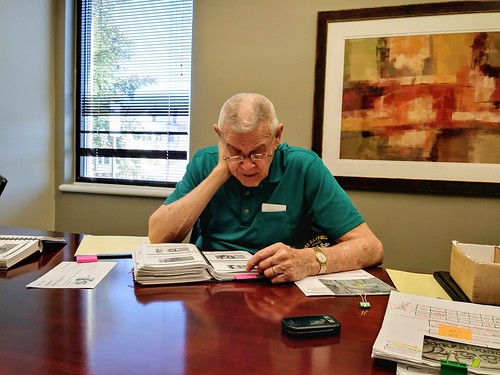
Bill Fivaz reviewing Cherrypickers' Guide entries
at an October 24, 2019, editorial meeting
Bill Fivaz, a coin collector since 1950, has earned recognition as one of the country's most respected authorities on numismatic errors and die varieties. He is a longtime contributor to the Guide Book of United States Coins (the "Red Book") and a past member of the United States Mint's Citizens Coinage Advisory Committee. With the late J.T. Stanton he coauthored the first Cherrypickers' Guide in 1990, launching the modern boom in interest in die varieties.
Larry Briggs is well known to the hobby community as a dealer, author, and educator. He served the American Numismatic Association as president of its Authentication Committee. A student of history and archaeology, Briggs served in the U.S. Air Force and worked for Ford Motor Company before launching his own business, Larry Briggs Rare Coins, in 1978. His specialties include error coins and die varieties, Liberty Seated coinage, and early American coppers.
Cherrypickers' Guide to Rare Die Varieties of United States Coins, sixth edition, volume II.
By Bill Fivaz and J.T. Stanton; forewords by Kenneth Bressett and Q. David Bowers; edited by Larry Briggs.
Publication date: 2020. Retail price, page count, and other details to be announced.
WHITMAN 1940-1978 ALBUMS AND FOLDERS INFO SOUGHT
David Lange writes:"I'm about halfway through writing my book on the albums and folders produced by Whitman 1940-78. This is the third volume in my comprehensive study of album/folder publishers and their product lines.
"If anyone has photos, literature or other memorabilia they'd be willing to have included in my book, I'd like to hear from them. The same goes for unique stories about the production and/or marketing of these items."
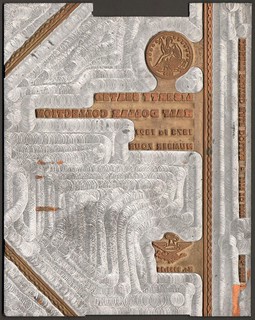
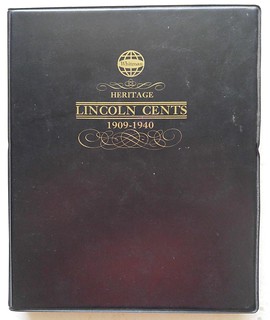
Dave adds:
"Above is a printing plate for a Sixth Edition coin folder, circa 1966. The other shows a prototype album called Heritage that Whitman planned as a replacement for the Bookshelf line, circa 1975. Both items are from my own collection."
Can anyone help? The story of Whitman's products is inextricably linked with the history of the hobby in the U.S. Please share whatever stories, information and material you may have. Dave can be reached at DavidWLange@outlook.com . -Editor
For more information see Dave's web site:
http://coincollectingboards.com/
VOCABULARY TERM: FINISH AND FINISHING, PART TWO
Dick Johnson submitted this important but lengthy entry from his Encyclopedia of Coin and Medal Terminology. Thanks! Here's the second and final part. -Editor
Relieving and highlighting. Dry ground pumice in very fine grain size is mixed with water until it has the consistency of thick soup. The operator douses a slurry of this mixture on the surface of a darkened medal while he holds it in his hand. It is then buffed by hand on a motorized muslin buffing wheel by lifting the dripping medal upwards under the rotating wheel. (The wheel is rotating counterclockwise, otherwise the operator would get a face full of slurry. A splash guard behind the buffing wheel collects the spun off slurry instead.) It is certainly understandable why this equipment is called wet wheel and the process wet-coloring.
The operator rotates the medal by hand then makes a couple of passes under the buffing wheel. The buffing action heats up the medal. By adding more pumice slurry he lowers the temperature so his fingers can control the medal. He repeats the slurry and buffing process as often as necessary for each side of the medal. Then he will buff the edge, rotating it while the revolving buffing wheel is in motion. Skill comes in handling the slippery moist medal, and not dropping it, while making an even two-tone color on both sides, with an edge to match.
The buffing wheel removes the darkened surface in areas where it can reach – flat surfaces and high areas of the detail. Since it does not touch the surface in the crevices and the corner areas it does not remove the darkened surface there. Thus the completely relieved medal would be light (the color of the original bronze or silver) on the flat and high surfaces, and the contrasting dark color in the crevices and corners. This total process creates the light-and-dark, two-toned effect to give it its highlighted appearance. The optical effect is to make the object's relief in greatest contrast for the human eye to perceive. Highlighting accomplishes this.
Drying and lacquering. After their treatment under the wet wheel, the medals are washed under running water of all the pumice slurry. They are then laid on a flat rack accommodating a dozen or so medals to be dried. The rack is then placed under ultraviolet lights (or in an oven) to completely remove all moisture.
Moisture is the enemy of the next step – lacquering. A wet spot, the tiniest bit of water, or a person sneezing on the medal's dry surface, will, in time, cause dark spots to form on the medal's surface under the lacquer (it is even called water spot). Every effort is made to dry the medals thoroughly, both sides, then get them in the lacquer spray booth at once. The rack is laid on a turntable in the spray booth. A spray gun – the best method
For applying lacquer – is passed over the medals once back and forth. The rack is rotated one quarter turn. The medals are sprayed again, once. Thus the medals have received the minimum amount of lacquer but in two directions, once horizontal, once vertically.
This thin coating of lacquer is perfect. It is so thin (less than a few thousandths of an inch) it cannot be seen with the naked eye. With any additional spraying the lacquer would build up in the corners and be unsightly. Dipping causes this more so, and brushing (the only other ways of applying lacquer) leaves brush marks. Spraying is ideal.
Applying the light lacquer coating while the medals are still warm from their heat lamp drying treatment will give a matte appearance to their surface. If a glossy finish is desired additional passes of the spray gun with a heavier coating will increase the reflectiveness to give the surface a shinny appearance.
The lacquer is usually clear. However, the lacquer can be colored, by adding metal powders (bronze powders), dyes or tints. Thus the spraying can keep the color of previous metal coloring (with transparent lacquer), or change it drastically, or only slightly.
With one side of the medals sprayed both directions, an empty rack is placed over the medals, and by holding the two racks tightly together, the operator can flip this over, to lay the second rack on the turntable and spray the second side of the medals. The lacquer drys almost instantly, the finishing of the medals are now complete and need only to be carried to the next workstation for any mounting, fabricating, edge lettering or numbering, or for inspection and packaging.
Imitating gold and silver. Not surprising, a lot of the activity in the finishing department is to make metal objects appear more attractive or desirable. Base metal items are often desired to be colored gold or silver. Undoubtedly this is a carry over from the jewelry field where so many of these processes were developed. Objects are struck or cast in base metals for the lower metal cost and given a surface, or coating, or finish, to appear as the more expensive noble metals.
While some metal compositions are chosen to imitate gold – brass, goldene, oroide – several methods imitate gold with layering (as rolled gold), clad, or electroplating with the outer layer actually gold. nickel silver is a composition in imitation of fine silver. But silver can even be imitated with silver wash, silvered, silverclad, and silverplate. The finishing department must be able to work with all of these, but most often utilizes gold and silver plating.
Electroplating. A well equipped finishing department for medal manufacturing will require both gold and silver electroplating tanks. These are used for finishing medallic items with the required surface color by plating. Usually, because the finishing foreman has the knowledge of electrolysis, he is also in charge of making galvanos by electrolysis even though this is a production of the item, not just the finishing (unless the galvano is required in a further production step, as a dieshell, in which case it is not required to be finished).
Medallic items to be plated are placed on racks which are immersed in the electrolyte solution. Anodes of the pure medal – gold or silver – are also in the solution. The items to be plated are the cathode. Electric current is turned on and, by the process of electrolysis, the metal is leached from the anodes and deposits on the cathode (the medallic items). A further description of this process is given under the entry on electroplating.
Patina finishes. While oxidizing (sulphatization) with a darkening chemical and highlighting (by relieving) is but one method of finishing a medal, a medal can also be finished with a patina. Patina finishes offer a range of surface protection – in a spectrum of possible colors! With a quantity of browns and greens for bronze items and grays and blacks for silver. The choice of a patina is an artistic one, it should be made to harmonize with the design or amplify the theme. It is often made in consultation between the sculptor or creator of the design and the finishing department foreman.
Each patina finish has its own methodology, and these techniques of application may range across a broad spectrum of activities. The variables concern: (1) the temperature of the medal, (2) the temperature of the patina solution, (3) how a solution is applied, (4) how long a solution is applied, (5) the type of applicator (if any), (6) any wet wheel application, (7) how a medal is supported while work is performed on it, (8) how the solution is allowed to set or dry, (9) pH of an acid solution, others.
There are, perhaps, forty or more commonly used patina formulas for medals. This despite the 1,126 different patinas listed in Hughes and Rowe, the standard work on patinas for the field of metal coloring. The authors recommended only 344 of these formulas and techniques. The Society of Medalists issues, created by Medallic Art Company, all have different patina finishes up to about issue #96. Although some are slight modifications the attempt of the Society was to issue a different patina for each issue. This medal series exhibits, therefore, examples of what can be done in a modern finishing department. An even more dramatic series was the Religions of the World, issued by Presidential Art Medals in which 15 different medals, each a different religion, each with a different patina.
The entry under patina lists the colors, chemicals, and names of the more popular patinas. The reader is directed there for these specific patinas.
Enameling adds color. The finishing department must also be able to do enameling as well as other finishing processes. Enamel adds color by applying tiny colored glass beads in an enclosed area on the surface of a medallic item. The cloisonné process requires fences or sides of relief to contain these loose beads, but an astute designer can work these raised surfaces into the overall design. Separate color beads are added for each different color.
With the medal laying flat and all areas to be colored with enamel filled with loose glass beads the piece is then fired. It is placed in an oven which melts the beads which become hardened and fixed in position. Enamel is essentially colored glass applied to a metal object. It is the most ideal way to add different colors to a medallic item, the colors are permanent and solid. However, since the enamel is glass it is susceptible to breaking, particularly near the edges.
Fabricating and mounting. To complete a medallic item the finishing department is required to do any final steps in its manufacture by fabricating – bringing together any additional assembly, like placing a ribbon drape on a medal – or mounting the item, as on some other object. Further details on these can be found in the entries on fabricated and mounting.
Thus we have observed that in contrast to coins, which require no finish (that's why it's called coin finish), medals require and can be adorned with a great variety of finishes. It is the finishing department that accomplishes all these functions.
Word List #19
Terms of Finishes, Finishing and Patinas
abrasive blasting: jewelry finish
acid patina: lacquered
aerugo nobilis: Light brown
antique bronze: Light bronze
antique finish: luster
antique green: mahogany finiah
Antique silverplate: mat, matte surface
applied finish: matte-ground
appressed finish: Medium brown
artistic green: Metallic bronze
blacking: Old English
Blue (turquoise): organic coating
bluish-green: Overcolor
bright dip: oxidation
bright finish: Pale brown
bronzing: Pale red-brown
Brown-gray: pearl essence
Brown-green: Red bronze
brush finish: Red mahogany
Chocolate brown: relieved
coin finish: Roman gold
colorized: Rose gold
color sample: Russet brown
Copper antique: satin finish
Dark brown: scratch brush
Deep yellow goldplate: sgraffotp
fire-bronzed: silverplate
French finish: Steel gray silverplate
French-gray finish: stipple
Glossy light bronze: tinted lacquer
goldplate: torch finish
gold tint: undercolor
Gray-bronze: vapor finish
Green patina: varnished
Green-blue: Verde antique green
Green-brown: verdigris
highlighted: wet colored
immersion finish: White brown
incrusted patina: yellow-bronze finish
The terms in SMALL CAPS have entries in this encyclopedia; those terms not in small caps have meaning the same as every-day language.
Looking for the meaning of a numismatic word, or the description of a term? Try the Newman Numismatic Portal's Numismatic Dictionary at: https://nnp.wustl.edu/library/dictionary
Or if you would like a printed copy of the complete Encyclopedia, it is available. There are 1,854 terms, on 678 pages, in The Encyclopedia of Coin and Medal Technology. Even running two a week would require more than 19 years to publish them all. If you would like an advance draft of this vital reference work it may be obtained from the author for your check of $50 sent postpaid. Dick Johnson, 139 Thompson Drive, Torrington, CT 06790.

WENDELL LEWIS PHINNEY (1884-1974)
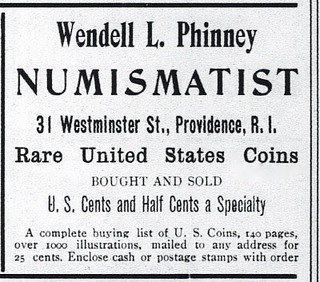 Wendell Lewis
Phinney (1884-1974), born June 10, 1884, at Pawtucket, son of George Frederick Phinney (1857-1943), and Addie Frances Slocum (1862-1944).
Wendell Lewis
Phinney (1884-1974), born June 10, 1884, at Pawtucket, son of George Frederick Phinney (1857-1943), and Addie Frances Slocum (1862-1944).
He was the grandson of Squire Z. Phinney a tobacconist who made cigars and sold wholesale tobacco.
Together with George Barton, and George Carpenter Arnold he attended the Lyman Haynes Low and Chapman Brothers coin sales held on June 18th and 19th, 1902.
Phinney was an early American copper specialist of U. S. Cents and Half Cents.
Phinney's interest with U. S. Large Cents grew more intense in April 1905 wanting to known more about 1794 varieties and Hays attributions wanting to get a copy of his book.
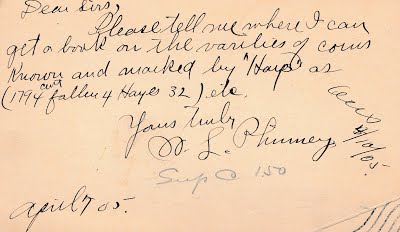
April 7, 1905. "Please tell me where I can get a book on the varieties of coins known and marked by "Hays" as (1794 cent fallen 4, Hayes 52) etc. Yours truly, W. L. Phinney"
The 1906 Providence City Directory lists him on page 1591 with a display advertisement. He sells his 140 page fixed price catalogue illustrated with over 1000 Rare United States Coins for only 25c. This is an Alexander Sigmund Bowman catalogue, The Hub Coin Book, probably issued with his name imprinted buying a box of 100.
The 1906 Providence City Directory lists him on page 633 as a clerk at 4 Market Square, Room 10, and as Numismatist at 31 Westminster Street, boards at Pawtucket.
On January 30, 1907, he married Lila Edith Trescott (1886-), at Attleboro, Massachusetts. They had a daughter Dorothy Eldora Phinney (1910-2008).
In 1940, he lived at 125 Stanley Street, Attleboro, Massachusetts.
In 1942 he is listed as a contract jeweler.
He died on March 20, 1974 at Attleboro, Massachusetts.
To read the complete article, see:
PHINNEY, WENDELL LEWIS
(https://sites.google.com/a/numismaticmall.com/www/numismaticmall-com/phinney-wendell-lewis)
The entire inventory of the Lupia Numismatic Library is for sale. Individual items will be available before the remaining archives are broken up into parcels sold at philatelic auctions in the U. S. and Hong Kong. Check NumismaticMall.com frequently as dozens of new items with estimates will be posted daily until everything is sold.
All inquiries will be given prompt and courteous attention. Write to: john@numismaticmall.com .
CHICAGO HALL OF FAME INDUCTS HARRY FLOWER
The Chicago Coin Club has announced the eleventh inductee into its Hall of Fame. -Editor
Inducts Harry Flower Into its Hall of Fame
The Chicago Coin Club announces that the eleventh person to be inducted into its Hall of Fame is Albert Einstein specialist Harry Flower. His Hall of Fame citation has been published on the club's Hall of Fame web page, www.chicagocoinclub.org/projects/hof.
Twelve Hall of Fame inductees have been selected. The final one will be announced in December, during the Chicago Coin Club's centennial year, 2019.
The Chicago Coin Club was organized in 1912 as American Numismatic Association Branch No. 1, and reorganized under its present name in 1919. All are invited to join. To become a member you must attend a meeting and submit an application along with a membership fee of $20 ($10 for Junior membership). A first reading of your application will be held at this meeting, and a second reading at the next monthly meeting, following publication of your name in the club newsletter. (You are not required to be present for the second reading.) Upon membership approval, you will become a member.
The Chicago Coin Club holds monthly meetings in downtown Chicago, plus at major numismatic conventions such as Central States, with a speaker featured at every meeting except the annual auction, held at the November meeting.
Here is the text of the Harry Flower entry. -Editor
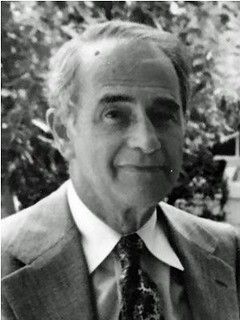 Early in the 1950s Glenn B. Smedley (Hall of Fame
No. 8) got Harry Flower started as a collector. He applied for ANA membership in November 1954, listing his specialty as U.S. paper money. Mr. Flower soon became active in his
local Oak Park Coin Club, and on Sept. 10, 1958 joined the Chicago Coin Club as member No. 695. In 1961 he was elected a Governor and received the Best in Show Exhibit Award at
the Chicago Coin Club Fall Festival; the following year he was appointed Exhibits Chairman for this short-lived annual show. He presented many programs to the club on a wide
variety of subjects over the years. A frequent exhibitor at meetings, he received a First Place Cabeen Exhibit Award in 1990 and collected many Second Places and Honorable
Mentions.
Early in the 1950s Glenn B. Smedley (Hall of Fame
No. 8) got Harry Flower started as a collector. He applied for ANA membership in November 1954, listing his specialty as U.S. paper money. Mr. Flower soon became active in his
local Oak Park Coin Club, and on Sept. 10, 1958 joined the Chicago Coin Club as member No. 695. In 1961 he was elected a Governor and received the Best in Show Exhibit Award at
the Chicago Coin Club Fall Festival; the following year he was appointed Exhibits Chairman for this short-lived annual show. He presented many programs to the club on a wide
variety of subjects over the years. A frequent exhibitor at meetings, he received a First Place Cabeen Exhibit Award in 1990 and collected many Second Places and Honorable
Mentions.
Mr. Flower (October 16, 1912 - May 24, 2000) was born in Poland and immigrated with his family to Lexington, Mississippi in 1914; they moved to Chicago when he was a teenager. He enrolled at the University of Illinois at Champaign in 1930, but his education was interrupted by the Depression and he did not complete his degree in pharmacy (at the Chicago campus, as required then) until 1937. After two years' post-graduate experience, he became a Registered Pharmacist, though he continued to live with his parents until his marriage in 1944. About 1947-48 he opened his own business, Flower Drugs, an old-time pharmacy with custom pills and cough syrup, operating it for about a quarter century.
His numismatic interests covered the entire field of numismatics: primitive money, ancient coins, paper money, world coins, tokens, and medals, including altered coins and paper money, cut and counterstamped coins, and gold coins, but he eventually specialized in Judaica in Numismatics, particularly tributes to Albert Einstein. Mr. Flower joined the American Israel Numismatic Association soon after it was formed in 1967, serving as Regional Vice President 1973-80 and Regional Director 1980-88. In 1984 AINA published his definitive 32-p. catalog, Tokens & Medals issued by Israel Numismatic Societies. He was also active in the Israel Numismatic Society of Illinois, serving as President 1969-72, and was elected President of two other Chicago-area coin clubs at various times. He is best known, however, as the author of "Numismatic Tributes to Albert Einstein," The Numismatist January and February, 1987 (Third Place Heath Literary Award, reprinted November 1987, 44 p.), and for forming the finest collection of Albert Einstein medals, tokens, coins, and paper money.
Mr. Flower won First Place awards in his category for exhibits at three AINA conventions in the 1970s and a Second Place exhibit award at the 1984 ANA Convention. In 1992 he was voted a Numismatic Ambassador. Affectionately known to some as "Mr. Einstein" because of his laser focus on Einstein tributes, he is fondly remembered by Chicago Coin Club members for his generosity and willingness to advance numismatic knowledge: "He was always willing to help a fellow collector."
To read the complete article, see:
Hall of Fame – Chicago Coin Club – Member 11 Harry Flower
(http://www.chicagocoinclub.org/projects/hof/m11.html)
To read the earlier E-Sylum article, see:
CHICAGO HALL OF FAME INDUCTS ARLIE SLABAUGH (https://www.coinbooks.org/v22/esylum_v22n38a15.html)
HEADLESS SOLDIER MEDAL INFORMATION SOUGHT
John Sallay submitted this grisly award medal for reader assistance. Can anyone help? -Editor
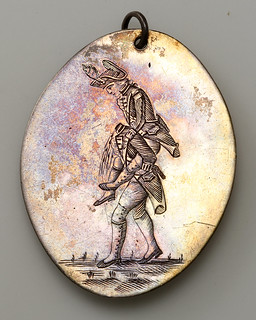
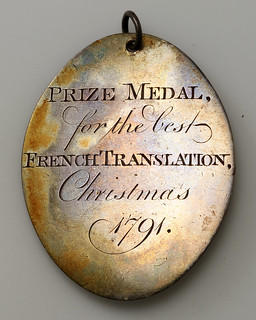
With Halloween coming in a few days, I thought this might be a good time for a query on the pictured medal, showing a headless soldier – with blood gushing out of his neck – carrying a comrade piggyback. Does anyone know what story or circumstance this vignette might be referencing?
This silver school medal is British, awarded for "the best French translation" and measures 37mm x 47mm. The Christmas date may seem unusual or meaningful, but it was fairly common during this period for these awards to be made at Christmas and Midsummer, which were the ends of the first and second terms of the school year. Given the 1791 date and that the prize was for a French translation, I first assumed that the vignette had something to do with the Reign of Terror during the French Revolution and/or the beheading of Louis XVI. However, those events didn't happen until 1793.
The Headless Horseman that most of us know from Washington Irving's "The Legend of Sleepy Hollow" (1820) also seems a little too disconnected, so to speak. That story relates to a folk tale about a Hessian soldier who was killed in the American Revolution during the Battle of White Plains in 1776. According to the legend, the poor fellow was decapitated by an American cannonball. His comrades carried off his body and buried him at the Old Dutch Church of Sleepy Hollow, but the remains of his head were left on the battlefield. So, the headless soldier's ghost rose, to ride on Halloween in search of his lost head. Given the American connection, rather than British or French, and the fact that the headless soldier is the rider rather than carrier, it doesn't quite seem to fit.
Great medal, and a subject I've never seen before. Does the design motif ring a bell for anyone? -Editor
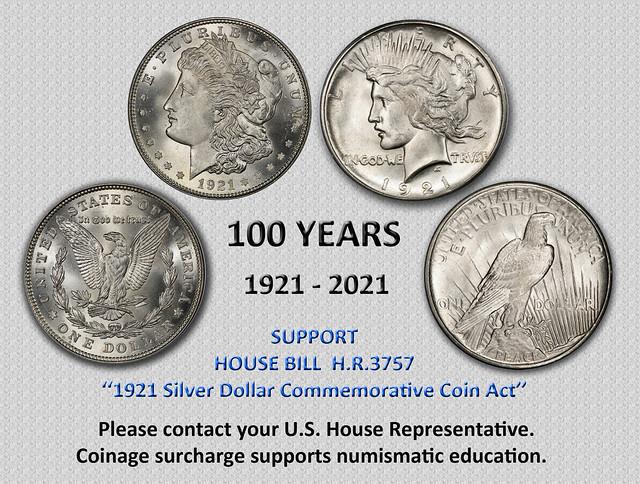
PAN SHOW FALL 2019 PHOTOS
Rick Lank of Hagerstown, MD attended the recent Pennsylvania Association of Numismatists (PAN) show in Monroeville, PA. He kindly provided a number of photos. Here are a few; see the complete album online for more. -Editor

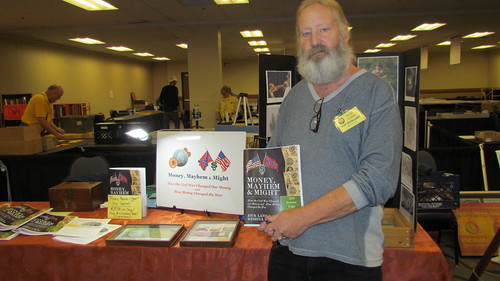
Rick with his book
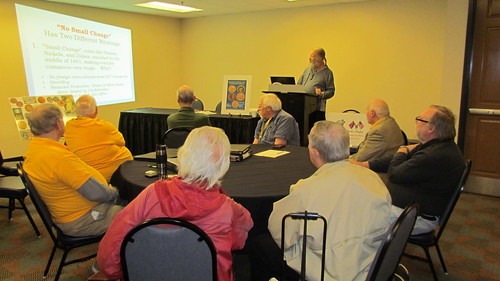
Rick's "No Small Change" talk on Saturday
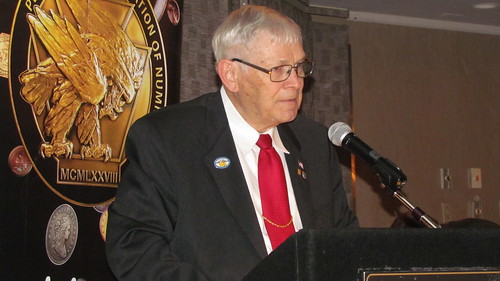
PAN Banquet speaker Clifford Mishler
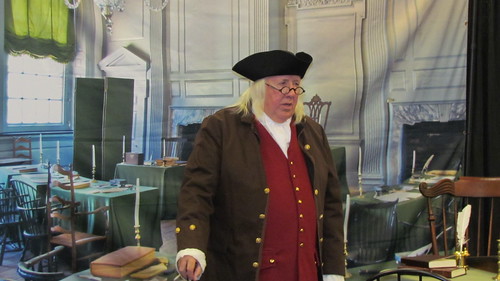
Pat McBride as Ben Franklin
To see the complete photo album: https://www.flickr.com/photos/coinbooks/albums/72157711526666361 (https://www.flickr.com/photos/coinbooks/albums/72157711526666361)
As discussed earlier, Rick is working to wrap up his new book on numismatics of the Civil War: Money, Mayhem and Might. -Editor
For more information on Money, Mayhem and Might, see:
https://talisman-coiner-productions.us/
http://www.money-mayhem-might.us/
For more information on PAN, see:
https://pancoins.org/
To read the earlier E-Sylum article, see:
NEW BOOK: MONEY, MAYHEM AND MIGHT (https://www.coinbooks.org/v22/esylum_v22n34a06.html)
STEPHEN ALBUM 5TH INTERNET-ONLY AUCTION
This press release features a few highlights from the upcoming Stephen Album Rare Coins sale. -Editor
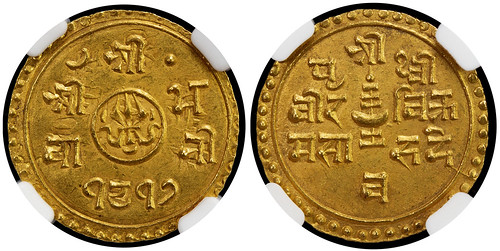
LOT 453 NEPAL: Prithvi Vira Vikrama, 1881-1911, gold ½ mohar
Stephen Album Rare Coins has published their 5th Internet-Only Auction. Bids can be placed now on the bidding website, and live bidding is also available during the live session which begins at 10:00am PST on Monday 4 November 2019. The sale features exactly 750 individual coin lots with starting prices ranging from 30 USD to 750 USD.
The coins in the sale range from all areas and time periods, including ancient coins, medieval Islamic coins, modern machine-struck coins from all continents, as well as a small number of modern coin issues.
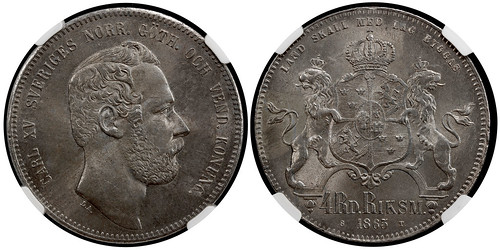
LOT 496 SWEDEN: Carl XV, 1859-1872, AR riksdaler species, 1865
One category that is expected to perform well is the Ottoman Empire, which includes selections from the Hans Wilski Collection. Totaling exactly 100 lots, the Ottoman section of the sale contains a large variety of types from across the entire time-span of the empire.
Another area of the auction that is expected to perform well is the Iraq machine struck coinage, a series that has been achieving high prices in recent sales.
It is possible to bid prior to the auction, and it is also possible to bid live during the auction as the lots hammer down one at a time.
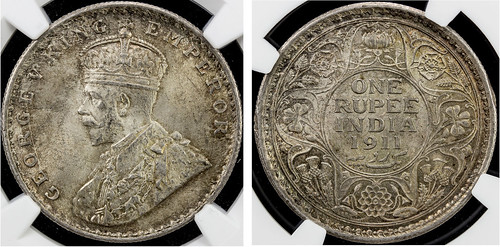
LOT 730 BRITISH INDIA: George V, 1910-1936, AR rupee, 1911
All bids must be placed through the online bidding website at:
https://www.sarc.auction/
DUANE FEISEL TOKEN SALE CLOSING NOVEMBER 30, 2019
Duane Feisel has a token sale closing November 30, 2019. Here are some highlights from his recent email to bidders. -Editor
The listing for my upcoming mail bid sale has been published on-line (color version) by NTCA, and the b/w printed version in "Talkin' Tokens" should soon be delivered through the mail. Bids have already started to arrive – there seems to be a lot of interest in the great selection of diverse material being offered. By the way, if you are not now a NTCA member and want membership information, please let me know – a variety of membership plans are available.
There have been a number of corrections – some major, some minor – to the original listing as sent out to my emailing list as well as what is published by NTCA. Please let me know if you want me to email you a copy of the revised auction list.
All the posting of lot photos and descriptions has been completed to my photo hosting site – accessible at:
https://collector-ca.smugmug.com/Tokens-Exonumia/2019-NOVEMBER-MAIL-BID-SALE/
Additionally, a few photos of requested pieces have been added.
An impressive selection of lumber company tokens, mostly from the Terry Trantow estate, is part of the sale. Astute work by a dedicated collector in correcting the attribution for one nice maverick piece now results in this amended listing:
Lot 109: WILL BARNES' WOOD YARD
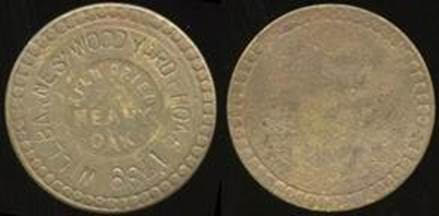
109 WILL BARNES' WOOD YARD PHONE 1739 (i) /
KILN DRIED / HEAVY / OAK // (uniface), (Pine Bluff AR),
br rd 28mm. Listed U5 R9. G3- MB$75
Then there is this item included in a nice grouping of Nevada Tokens – listed with incomplete information, but now corrected:
Lot 301: BONANZA HOTEL SILVER CITY, NEV.

301 GOOD FOR ONE DRINK / BONANZA HOTEL, / J.J. WINN, /
SILVER CITY, NEV. // Drink / Jesse Moore / AA / Whiskey /
(sm: The Whitehead & Hoag Co. Newark, N.J.), ce black imprint re 47x24mm.
Listed 1728. G5-MB$50
Among a large selection of saloon tokens is this rarity:
Lot 34: THE CORNER SALOON APACHE, O.T.
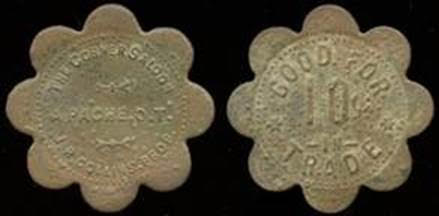
34 THE CORNER SALOON / APACHE, O.T. / J.R. COLLINS, PROP. //
Good For / 10¢ / In / Trade, br sc-8 25mm, unearthed w/raised dots.
Listed (incompletely) 1. ………. G2-MB$1,000
if you plan to place bids, the earlier the better! Bidding will close to advance bidding November 30.
Cool Oklahoma Territory piece! -Editor
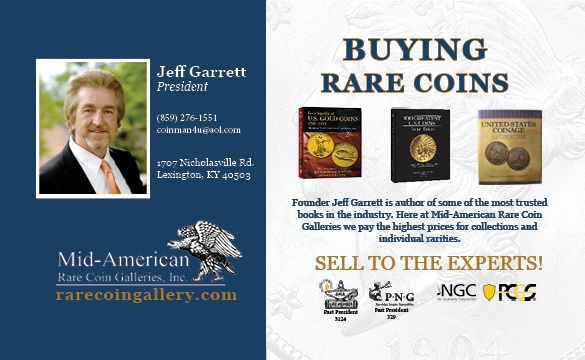
JOHN W. ADAMS COMITIA AMERICANA MEDALS
The 110-lot Stack's Bowers sale of the John W. Adams Collection of Comitia Americana and Related Medals is a highlight of the firm's upcoming November Baltimore sales. Here are some selected pieces, but see the complete catalog for much more. This is a rare opportunity to acquire some of the rarest and most important medals in American history. -Editor
Lot 2001: Original Silver Washington Before Boston Medal
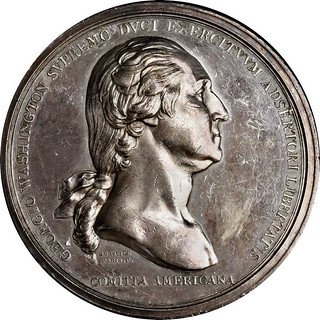
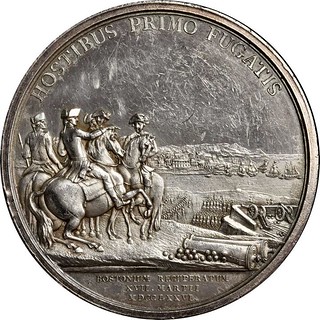
1776 Washington Before Boston medal. Betts-542, Musante GW-09-P1, Baker-47, Mooney M5. Silver. Original striking. Paris Mint. 69.0 mm, 2301.1 grains. 4.3 - 4.6 mm thick. About Uncirculated.
Plain square edge. A magnificent specimen of this most august of all American medals, the first medal ever authorized by the Continental Congress and the #2 ranked medal among the 100 Greatest American Medals and Tokens, trailing only the Libertas Americana medal. While any specimen of the Washington Before Boston is impressive, showcasing the superb relief of Duvivier's version of the famed bust by Jean-Antoine Houdon, numismatists cherish original strikings above all others. Among originals, the dramatic importance of Washington's unobtainable gold specimen is followed closely by the nearly unobtainable silver strikings like this one.
Obverse: A profile of Washington, after Houdon's masterful bust, with hair tied with a ribbon and the bust neatly truncated. Duvivier's signature DuVIVIER / PARIS F. appears on two lines beneath the bust truncation, while COMITIA AMERICANA appears on a straight line in the unbordered exergue. The peripheral inscription GEORGIO WASHINGTON SVPREMO DVCI EXERCITVVM ADSERTORI LIBERTATIS translates to "George Washington, supreme commander of the armies, defender of liberty."
Reverse: Washington, on horseback at left, stands with four mounted officers overlooking Boston and its harbor from Dorchester Heights. Ships at full sail depart at right on the horizon, while troops, cannons on their carriages, stacked cannonballs, and two unmounted cannon are at Washington's right. Washington gestures to the scene below. The legend HOSTIBUS PRIMO FUGATIS means "the first flight of the enemy," while the exergual legend BOSTONIUM RECUPERATUM XVII MARTII MDCCLXXVI means "Boston recovered, March 17, 1776."
One of only five in private hands. See the catalog description for much more information on one of the most important medals in U.S. history. I'm glad to see reference to the study of Washington Before Boston medals by my numismatic mentor Glenn A. Mooney of Pittsburgh. -Editor
To read the complete lot description, see:
1776 Washington Before Boston medal. Betts-542, Musante GW-09-P1, Baker-47, Mooney M5.
(https://auctions.stacksbowers.com/lots/view/3-KEPA4/1776-washington-before-boston-medal-betts-542-musante-gw-09-p1-baker-47-mooney-m5-silver-original-striking-paris-mint-690-mm-2)
Lot 2053: Silver Daniel Morgan at Cowpens Medal
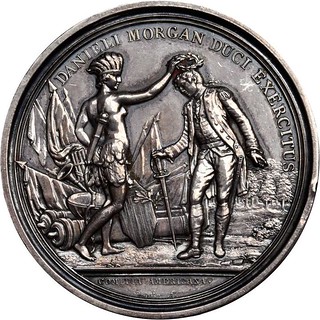
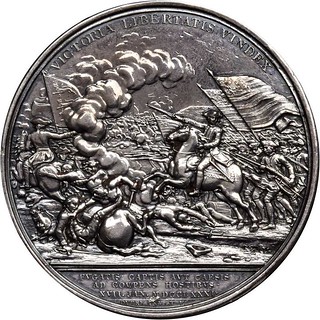
1781 Daniel Morgan at Cowpens medal. Betts-593. Silver. Original. Paris Mint. 56.1 mm, 1211.8 grains. 4.6 - 4.8 mm thick. Choice Extremely Fine.
Any original Morgan at Cowpens medal is of the highest rarity, even those struck in bronze. For whatever reason, these dies were never employed to produce restrikes at Paris like the dies for George Washington, Jones, Howard, and William Washington, nor were they carried to the Philadelphia Mint like the dies for Horatio Gates' medal. Instead, like Dupre's dies for the Nathanael Greene medal, a small run was made at Paris roughly contemporary to the production of the original gold medal and the dies were never used again. The Adams-Bentley census found three silver originals: the MHS piece, the one in Vienna's Kunsthistoriches Museum, and this one, the sole survivor in private hands. Among the seven original bronzes they listed, only three were privately held. The second of the bronzes in this collection appears to be unlisted in the Adams census, leaving a total collectible population from Dupre's original dies of just six pieces, of which this is the only silver strike that has survived outside of an institution.
When this medal brought $80,500 when it last sold in May 2001, it shattered a decades old record for the highest price realized by an American historical medal - $51,000 - formerly held by Anthony Wayne's own gold Comitia Americana medal, sold by Sotheby Parke-Bernet in 1978. As a contrast, in May 1999, just two years before this medal created a new price structure for rare American medals, Harry Bass's gem silver Libertas Americana medal realized $19,550 (now the price of a mediocre Mint State bronze specimen of the same medal) and his exceptional silver De Fleury medal realized $27,600. The record this medal set did not stand long. Before 2001 had ended, a Thomas Jefferson Indian Peace medal had crossed the six-figure mark, netting $115,000 in November 2001.
Five years later, in November 2006, Zachary Taylor's Congressional gold medal for the Battle of Buena Vista brought $460,000. Arguably, the Taylor medal record as most valuable American medal ever sold still holds, as other medals that have realized higher sums (like James Watson's Nobel prize and Jesse Owens' Olympic gold medal) are not of American manufacture despite their American relevance. Of course, at this point, dozens of medals have brought prices that surpass the $80,500 this medal brought in 2001. Not counting the 1936 Nobel Peace Prize we sold in 2014 for $1,116,250, this firm has sold no fewer than 46 medals for more than $80,000 (not counting all of the 1776 Continental "dollars" that could probably now be added to the list). Every one of those sales has happened since this medal first broke that barrier.
Obverse: The traditional reverse was considered the ob.verse by the Academy of Inscriptions and Belles-Lettres and by Jefferson himself. Alas, we hew to numismatic tradition. With flags and cannons - the traditional trophies of war - at left, the goddess America in her traditional garb and holding her traditional shield crowns Morgan, at right, with a laurel wreath. Morgan bows slightly, his sword grounded, with the rural scene of battle seen behind him. Beneath the exergue are the words COMITIA AMERICANA. Around the periphery: DANIELI MORGAN DUCI EXERCITUS or "Daniel Morgan, head of the army."
Reverse: Perhaps the most impressive and evocative battle scene in the realm of American medallic art, at least until the Mexican-American War masterworks of Charles Cushing Wright. Morgan, in the saddle and pointing forward with his sword, leads his soldiers from right to left. The Cowpens flag flies behind him at the front of his troops, who carry their muskets with bayonets fixed. A native ally stabs a fallen British cavalryman in the lower left, while other British troops, one mounted, scramble. A British flag and smoke rise from the left. The legend above VICTORIA LIBERTATIS VINDEX means "Victory is Liberty's defender." In the exergue, FVGATIS CAPTIS AVT CAESIS AD COWPENS HOSTIBVS XVII. JAN. MDCCLXXXI means "The enemy chased, captured, or killed at the Battle of Cowpens, January 17, 1781." In the lower exergue, Dupre signs DUPRE INV ET F or "Dupre conceived and made it."
Of course, the medal's history is the most important story, but its role as a price-barrier-breaker is interesting. I've been predicting and watching breakout price records for rare medals for some time. -Editor
To read the complete lot description, see:
1781
Daniel Morgan at Cowpens medal. Betts-593. Silver. Original. Paris Mint.
(https://auctions.stacksbowers.com/lots/view/3-KEPFR/1781-daniel-morgan-at-cowpens-medal-betts-593-silver-original-paris-mint-561-mm-12118-grains-46-48-mm-thick-choice-extreme)
Lot 2090: Original Libertas Americana Medal
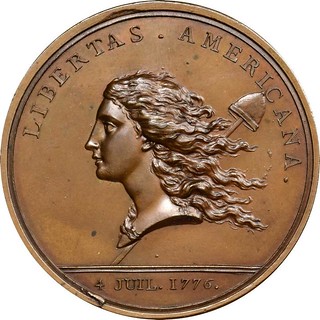
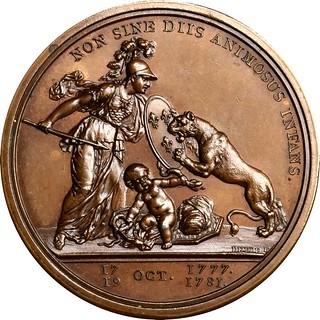
1781 Libertas Americana medal. Betts-615. Copper. Original. Paris Mint. 47.8 mm, 725.8 grains. 3.5 - 3.6 mm thick. Choice Mint State.
It is well known that Benjamin Franklin preferred Dupre's majestic design in copper. "The Impression in Copper is thought to appear best," Franklin wrote to Robert Livingston on April 15, 1783, though one wonders if he might have written something different if the piece he enclosed for Livingston was a silver one. Copper specimens like this one were sent to the members of Congress and other functionaries close to the government; it seems likely that more copper pieces were distributed in the United States than in France.
Cognizant of the historic moment they occupied, and appreciative of Franklin's largesse, it seems that most recipients of a Libertas Americana medal cherished it. The bulk of the mintage seems to have survived. Of course, to an 18th century non-numismatist, cherishing something meant handling it, displaying it, perhaps cleaning it now and again, thus few survive in Gem condition. The total population - perhaps 200 or so - is heavily weighted toward those with some handling. Not one in ten is as nice as this one.
The Libertas Americana Medal
There is almost nothing we can say about the Libertas Americana medal that has not been said before. It is the most recognizable early American medal, the unanimous choice as #1
in the 100 Greatest Medals and Tokens book, and the inspiration for many of the United States coinage designs of the 18th century. It is legendary beyond its rarity,
historic beyond its celebrated creation narrative, and important far beyond the world of numismatics.
While not properly a part of the Comitia Americana series - it was a medal authorized by Benjamin Franklin as an individual, not the Continental Congress - the Libertas Americana medal has been adopted into this group ever since Thomas Jefferson saw fit to place one in George Washington's set of Comitia Americana medals in the summer of 1789. By that time, the medal was several years old, as it had been completed and distributed by Franklin in the spring of 1783. Franklin sent his medal far and wide, in France, in the United States, and beyond. His postal accounts show that in April 1783 he twice hired a carriage to special deliver his medal to its recipient. Jefferson had one on display at Monticello, inventoried as "a medal by Dr. Franklin." The Dutch artist Johann-Georg Holtzhey had a friend write to John Adams to ask how he and his friends could obtain one. As the medals found their homes in April and May 1783, Franklin's mailbox filled up with thank you notes from across the continent. On April 15 of that year, Franklin sent a bundle of them to Philadelphia to hand out to the members of Congress, including a silver one for Congress' president, future Mint Director Elias Boudinot.
Obverse: "The Head representing American Liberty has its tresses floating in the air, to shew that she is in activity. The Cap carried on a Spear is her Ensign. The Date underneath is that of the Declaration of Independence."
Reverse: "The United States of America are represented by an Infant Hercules, cradled in a Buckler to shew that they are nursed in War. A Leopard, representing England, comes with two serpents to destroy the Infant. France represented by a Minerva, comes armed to his succour, and under her protection he strangles the two serpents, while she guards him from the Leopard, by her shield marked with Fleurs-de-Lis. The Legend is a line of Horace, importing that the Infant was not without divine assistance. The Dates below are those of the two Capitulations of Saratoga & York-Town, whereby two entire English Armies that had enter'd and ravaged the United States with fire & sword, were extinguished." In Franklin's symbolism, this depiction recalls Hera, the stepmother of Hercules, releasing two snakes to kill Hercules in his cradle; those two snakes were the armies of Burgoyne (defeated at Saratoga) and Cornwallis (defeated at Yorktown).
To read the complete lot description, see:
1781
Libertas Americana medal. Betts-615. Copper. Original.
(https://auctions.stacksbowers.com/lots/view/3-KEPKD/1781-libertas-americana-medal-betts-615-copper-original-paris-mint-478-mm-7258-grains-35-36-mm-thick-choice-mint-state)
Lot 2109: United States Diplomatic Medal
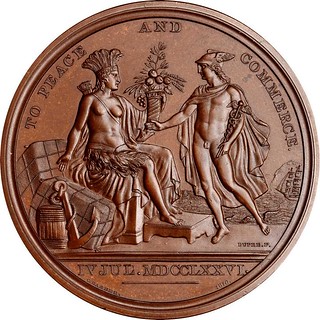
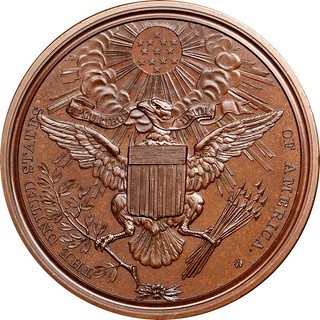
"1776" (after 1876) United States Diplomatic medal. Loubat-19, Julian CM-15. Copper. U.S. Mint copy dies by Barber (1876). Philadelphia Mint. 67.9 mm. 2432.4 grains. 6.0 - 6.3 mm. Choice Mint State.
This is a very scarce medal. A single silver specimen is recorded on the mintage figures for the 1876/77 fiscal year, likely the one sent in April 1876 to Professor Jules Marcou, who supplied his original Diplomatic Medal cliches to the U.S. Mint to serve as models for William Barber's copy dies. According to Mint records, just 65 pieces were struck in copper from these dies between 1876 and 1904. Originals are beyond the realm of possibility for most, making this version of the Diplomatic Medal a very desirable item. The Chapmans bitterly called this production a "US Mint counterfeit" after they failed to sell their original to the Mint Collection.
The Diplomatic Medal
Approved by George Washington, influenced by John Adams and William Temple Franklin (grandson of Benjamin), and brought to fruition by Augustin Dupre, the United States Diplomatic
medal was the pet project of Thomas Jefferson. Appointed secretary of State by President Washington on September 26, 1789, Jefferson returned home the following month from Paris,
where he had been serving as Minister Plenipotentiary to the Court of Louis XVI. The following spring, in April 1790, he hatched a plan to create gifts for diplomats dispatched to
the United States, just as the crowned heads of Europe gave symbols of appreciation to the ambassadors assigned to their governments. After receiving approval from President
George Washington, Jefferson asked his charge d'affaires in Paris, William Short, to see the project to fruition, suggesting either Duvivier or Dupre as likely authors of the
medal, as they "seem to be the best workmen, perhaps the last is the best of the two."
Obverse: The first version of the Great Seal of the United States ever executed in medallic form, correctly showing the olive branch of peace at dexter (eagle's right) and the arrows of war at sinister (eagle's left, viewer's right). The eagle holds a banner inscribed with the national motto E PLURIBUS UNUM in his beak and an escutcheon or shield is displayed on his breast. A glory of 13 stars is atop the obverse, and the legend THE UNITED STATES OF AMERICA surrounds the arms at the periphery.
Reverse: An allegory of America, in her common guise as a Native American princess, holds a cornucopia or horn of plenty and gestures to bundles and a hogshead beside an anchor. She is approached by Mercury as Commerce, holding his caduceus. A ship representing Atlantic commerce and interactions with Europe is in his background. The legend TO PEACE AND COMMERCE is appropriate to the scene; the date July 4, 1776 is rendered in Roman numerals in the exergue.
Be sure to read the full catalog description. Great history -Editor
To read the complete lot description, see:
"1776"
(after 1876) United States Diplomatic medal. Loubat-19, Julian CM-15
(https://auctions.stacksbowers.com/lots/view/3-KEPND/1776-after-1876-united-states-diplomatic-medal-loubat-19-julian-cm-15-copper-us-mint-copy-dies-by-barber-1876-philadelphia-)
NUMISMATIC NUGGETS: OCTOBER 27, 2019
Here's a selection of interesting or unusual items I came across in the marketplace this week. Tell us what you think of some of these. -Editor
Augustus Denarius
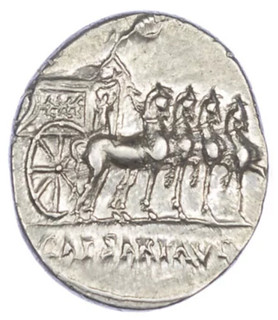
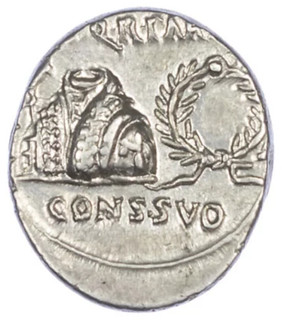
Augustus (27 BC-AD 14).
Silver Denarius, uncertain Spanish mint, c. 18 BC.
Obverse: Aquila, imperial mantle and wreath.
Reverse: Slow quadriga right; chariot ornamented with Victory design.
(RIC I –; RSC 80a; BMC 402).
Extremely Fine. Excellent metal. Scarce.
Beautiful coin - I don't recall seeing this design before. From the online stock of Baldwin's. -Editor
To read the complete lot description, see:
AUGUSTUS, SILVER DENARIUS (https://www.baldwin.co.uk/product/augustus-silver-denarius-2/)
Parthian Kingdom. Gotarzes II Tetradrachm

Lot 022. Parthian Kingdom. Gotarzes II. A.D. 40-51. AR tetradrachm. year 362 of the Seleucid era=51 A.D.
Parthian Kingdom. Gotarzes II. A.D. 40-51. AR tetradrachm (25.86 mm, 13.87 g, 12 h). year 362 of the Seleucid era=51 A.D. Diademed Head of Gotarzes II Left / Tyche Presenting Diadem to Gotarzes II-Greek Legend- "king of kings Arsaces the benefactor, the just, the illustrious (Epiphanes), the friend of the Greeks (Philhellen)", without mentioning his proper name. S65.28-32. Good VF.
Worn, but a nice well-centered and well-struck piece. From the Agora Auctions sale #94 closing November 4. 2019. -Editor
To read the complete lot description, see:
Lot 022. Parthian Kingdom. Gotarzes II. A.D. 40-51. AR tetradrachm. year 362 of the Seleucid era=51 A.D.
(https://agoraauctions.com/listing/viewdetail/46830)
Sasanian Empire Shapur I Dinar
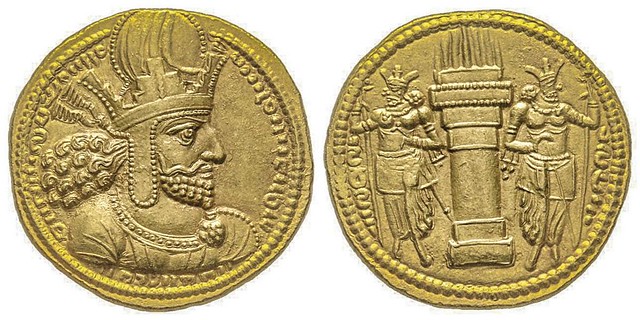
Kingdom Sassanid
Shapur I 241-272
Dinar, Ctesiphon, AU 7.33 g.
Obverse: Bust right
Reverse: Altar fire between two guards. In the field to the right, under the guardian's elbow, three points arranged in a triangle
Ref: Göbl I / 1, 21, SNS type IIc / 1b, group d / 1, style P, pl. 31, 143 var., Sunrise Collection 739 var.
Ex Sale Heritage 09/2015, lot 29159
Conservation: Superb
The sasanian empire, or neo-Persian empire, officially known as the Iranian Empire, was the last kingdom of the Persian empire before the advent of the Islam.
Here's a Google-translated lot description from the Éditions V. Gadoury November 16, 2019 sale. -Editor
To read the complete lot description, see:
Lot 294 Kingdom Sassanid Shapur I 241-272 Dinar, Ctesiphon
(https://www.biddr.ch/auctions/gadoury/browse?a=770&l=807794)
1744 Dutch Gold Medal
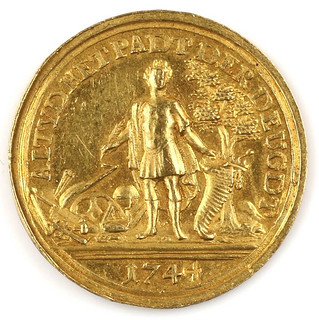
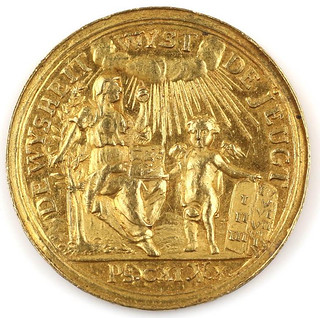
Description: Dutch, "De wysheit wyst de jeugt" obv. :"altyd het padt der deugd" translated: Wisdom leads the youth to the path of virtue centring a scholar surrounded by scientific instruments and Abraham on the reverse. 1744, Provenance: Collection of the late Mr. Arend Bredius (1932-2019), The Hague, Gross weight 3 grams.
Interesting medal. A very busy design, but you don't often see scientific instruments on coins or medals. From the November 14, 2019 sale of Venduehuis der Notarissen in the Netherlands. -Editor
To read the complete lot description, see:
An antique gold medal (https://www.invaluable.com/auction-lot/-1-c-3544B81BE3)
1828 Imperial Russian Silver Medal
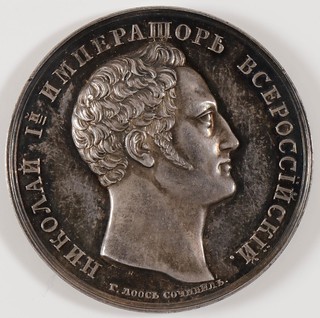
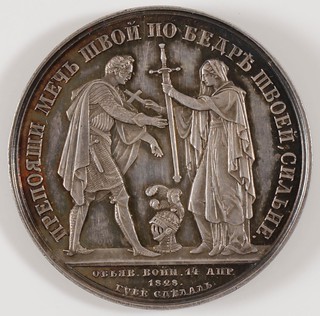
Description: IMPERIAL RUSSIAN SILVER MEDAL, 1828. Comprising a very fine silver medal commemorating the Declaration of War against Turkey in 1828. The obverse with a relief profile bust portrait of Nicholas I and the verso with female figure presenting a sword to the Emperor. Uncirculated condition. Diameter 28.5 mm. Diakov 470.2.
Provenance:
The lifetime collection of Russian/Ukrainian émigré George Odarchenko (1929-1999).
Decent medal. There are so many different Russian medals; this is a typical example. Strong portrait, well executed. -Editor
To read the complete lot description, see:
IMPERIAL RUSSIAN SILVER MEDAL, 1828 (https://www.invaluable.com/auction-lot/-1-c-9874125B7D)

THE ANCIENT COIN PETTING ZOO
The student newspaper of Lawrence University in Appleton, WI published an article about the classics department's annual Ancient Coin Petting Zoo. -Editor
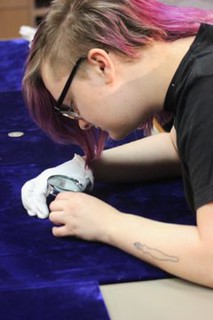 On Tuesday, Oct. 15, the Lawrence
University classics department hosted the Ancient Coin Petting Zoo. Put together by Assistant Professor of Classics Adriana Brook; Assistant Professor of Art History, Curator of
the Wriston Art Center Galleries and Museum Studies Interdisciplinary Area Program Director Beth Zinsli; and a half dozen classics students, it was located in the Wriston Art
Center Galleries. Eight coins from ancient Greece and Rome were on display for the public to touch and learn about. In addition to the coins, several Greek ceramic pots from
approximately the fourth century BCE were on display as well.
On Tuesday, Oct. 15, the Lawrence
University classics department hosted the Ancient Coin Petting Zoo. Put together by Assistant Professor of Classics Adriana Brook; Assistant Professor of Art History, Curator of
the Wriston Art Center Galleries and Museum Studies Interdisciplinary Area Program Director Beth Zinsli; and a half dozen classics students, it was located in the Wriston Art
Center Galleries. Eight coins from ancient Greece and Rome were on display for the public to touch and learn about. In addition to the coins, several Greek ceramic pots from
approximately the fourth century BCE were on display as well.
This year, the event was animal-themed, so all of the coins had depictions of animals. Many had depictions of lions or men wearing lion-skin caps, a reference to Hercules. Others contained delightful owls, especially coins from the city of Athens. One from Roman-controlled Egypt even had a crocodile. The eight coins are a part of a larger collection of almost 400 coins given to the university by Otillia Buerger '38 in 1991, which has been appraised as the third best ancient coin collection in the U.S. While not on display regularly, the coins are utilized frequently by professors as a teaching aid to classes, and many students use the collection to do original research. A highlight of the collection is a large gold medallion from the late Roman Empire of which there are only two known copies. While that was not on display this time, there were several other wonderful coins for viewing.
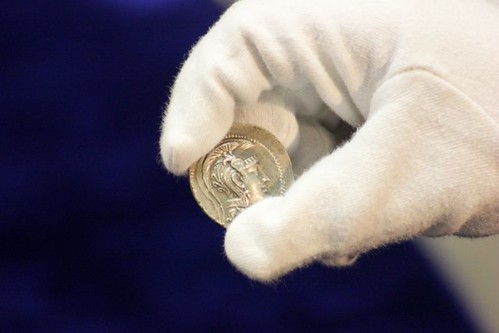
Fortunately, for those who missed this Petting Zoo, there will be an opportunity later this year when the classics department hosts the annual Classics Week in the winter: it is expected a second exhibition will be held during that time. It is a phenomenal opportunity to actually hold a bit of the ancient world in the palm of your hand.
Great idea! You know, there are lots of events where the public is invited to bring coins to the experts for identification and appraisal, but only in certain museums and at coin shops and shows can the public even see coins in person. Wouldn't it be great to take this concept out into the community and meet people where they are (and not just during Coin Week)? If Girl Scouts can sell cookies from a table in front of the supermarket, why can't someone set up a free coin petting zoo? Clubs and collectors - give it a try in your community! -Editor
To read the complete article, see:
Classics department holds annual Coin Petting Zoo (http://www.lawrentian.com/archives/1015567)
TWO FACES OF BEN FRANKLIN
Harry Waterson published an article titled "Two Faces of Ben Franklin - Mystery, Confusion and Discovery" (about two similar versions of a medal featuring Ben Franklin) in the October 2019 issue of The Clarion, the official publication of the Pennsylvania Association of Numismatists (PAN). With permission, here is an excerpt. Thanks to Harry and Clarion Editor Richard Jewell. -Editor
Here is The Saturday Evening Post (SEP) 200th Anniversary (1728-1928) medallion by Kilenyi
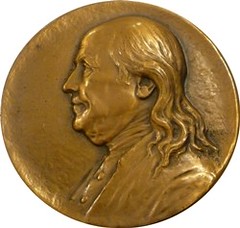
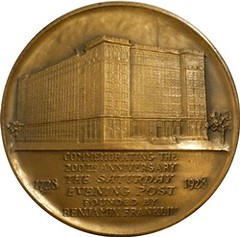
This is a 4-inch bronze medallion with Ben Franklin on the obverse and the home of Curtis Publishing on the reverse. 4,200 were struck by Whitehead & Hoag, Newark, NJ in 1928. It is Greenslet #GM-140
GM-140 COMMEMORATING THE / 200 TH ANNIVERSARY / THE SATURDAY / EVENING POST / FOUNDED BY / BENJAMIN FRANKLIN
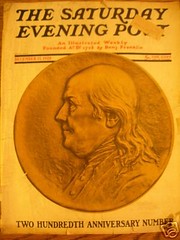 The Saturday
Evening Post is currently a bimonthly magazine. It was published weekly under this title from 1897 until 1969. While the publication traces its historical roots to
Benjamin Franklin, The Pennsylvania Gazette was first published in 1728 by Samuel Keimer. The following year (1729), Franklin acquired the Gazette from Keimer for a small sum and
turned it into the largest circulation newspaper in all the colonies. It continued publication until 1815. The Saturday Evening Post was founded in 1821 and grew to become
the most widely circulated weekly magazine in America. The medallion was the cover art for the December 15, 1928 issue, the Two Hundredth Anniversary Number and was a fixture on
its masthead thereafter for decades.
The Saturday
Evening Post is currently a bimonthly magazine. It was published weekly under this title from 1897 until 1969. While the publication traces its historical roots to
Benjamin Franklin, The Pennsylvania Gazette was first published in 1728 by Samuel Keimer. The following year (1729), Franklin acquired the Gazette from Keimer for a small sum and
turned it into the largest circulation newspaper in all the colonies. It continued publication until 1815. The Saturday Evening Post was founded in 1821 and grew to become
the most widely circulated weekly magazine in America. The medallion was the cover art for the December 15, 1928 issue, the Two Hundredth Anniversary Number and was a fixture on
its masthead thereafter for decades.
At this point the cataloguing gets muddled. Greenslet lists varieties GM-139 and 139A. Both are 4-inch medallions just like the SEP medallion but with different inscriptions on the reverse GM-139 THE CURTIS PUBLISHING COMPANY / THE SATURDAY EVENING POST / LADIES' HOME JOURNAL / COUNTRY GENTLEMAN / INDEPENDENCE SQUARE / PHILADELPHIA, PA. GM-139A THE CURTIS PUBLISHING COMPANY / THE SATURDAY EVENING POST / LADIES' HOME JOURNAL / COUNTRY GENTLEMAN / JACK AND JILL· HOLIDAY / CURTIS CIRCULATION COMPANY / INDEPENDENCE SQUARE / PHILADELPHIA, PA. Greenslet only illustrates the obverse of GM-139 and the reverse of GM-139A
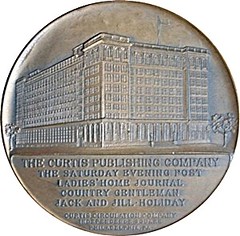
Since Greenslet numbers these two medallions ahead of the Anniversary medallion, the assumption is that these two medallions were struck prior to The Saturday Evening Post 1928 medallion. This is not true.
GM-139 The publications listed on this reverse all existed prior to 1928 so it is possible this medallion exists but an example has never been seen or catalogued. This has been an object of intense search in auction catalogs, books, periodicals, the Curtis Archives, the Newman Portal and the press. The Curtis Publishing Company Building on the reverse of the medallion was completed in 1921 so the span of time the medallion could have been issued and predate the Anniversary medallion was 1921 to1927. Melvin & George Fuld do not catalog this medallion. To add to the confusion Greenslet assigns to GM-139 the Fuld # for GM-139A. This is all circumstantial but the writer believes GM-139 does not exist. This is not to say Phil Greenslet made a mistake but he maybe presumed the medallion should exist so he catalogued it as if it did. Or he knew of one but didn't know it was the only one.
GM-139A This medallion does exist. Illustrated above. The Curtis Publishing Company medallion is easy to date from the internal evidence. Jack and Jill was first published in 1938 and Holiday was started in 1946. The Curtis Circulation Company was organized in October, 1946. This medallion must then date from 1946 or slightly later. It could not predate the SEP medallion.
1861 GOLD LIFE SAVING MEDAL
My Stack's Bowers November sale catalogs arrived with a thud on Friday. There's a lot of material to go through and I wish I had time to highlight more of it. Here's one lot that particularly caught my eye - a magnificent gold lifesaving medal. -Editor
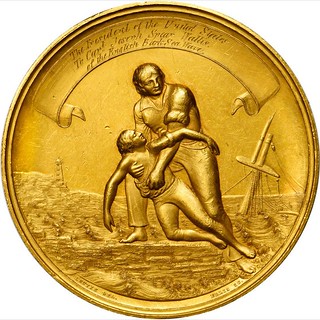
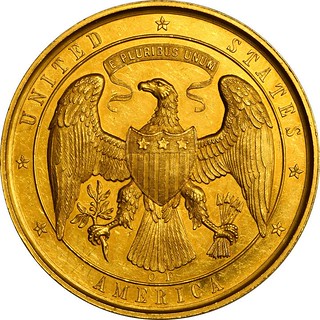
Undated (1861) State Department Life Saving Medal. First Class. Gold. 67 mm. 222.10 grams. Julian-LS-1. By Salathiel Ellis, after Emmanuel Leutze. MS-60 (NGC).
Obv: The Great Seal of the United States with a heraldic eagle at center, E PLURIBUS UNUM above and the legend UNITED STATES OF AMERICA around. Rev: A scroll engraved THE PRESIDENT OF THE UNITED STATES / TO CAPT JOSEPH SPEAR WALLIS / OF THE ENGLISH BARK SEA WAVE above scene of a rescue along a shoreline. LEUTZE DEL. and ELLIS SC. below.
This is an absolutely magnificent rarity from the US Mint representing one of the very earliest Life Saving medals awarded by the State Department. Measuring 67 mm in diameter and weighing in at over 7 troy ounces, it is remarkably impressive to examine in hand. The surfaces are a vibrant brassy-gold hue with tinges of apricot patina in the protected areas. Richly frosted luster on the devices contrasts considerably against the watery and reflective fields. The rims are sharp and square, with traces of a wire edge around much of the obverse. Minor hairlines show in the fields but the surface are free from any brightness or distracting abrasions. A pair of small marks in the left reverse field are the only consequential imperfections, but even these fail to draw the eye. The complexion remains attractive and well-composed, with eye appeal that is absolutely superior for the assigned grade.
This captivating gold medal was awarded to British Captain Joseph Spear Wallis for his rescue of passengers from the American ship David Brown, which sunk into the Atlantic in January 1861. The David Brown was a clipper based in San Francisco that was charted to transport wheat to Liverpool, England. It set out October 11, 1860 in the control of Captain Gordon G. Berry and began to make its way down and around South America and into the open Atlantic. It was occupied by 22 crewmembers and 24 passengers on this journey.
The David Brown started to take on water shortly after entering the Atlantic and was eventually abandoned by her crew in the open ocean on January 6, 1861, midway between South America and north western Africa. The occupants were split between two lifeboats and floundered for 10 days, suffering from exposure, hunger and thirst, before being recovered by a pair of ships. These included the Spanish Observador and the British Sea Wave, which was in command of Captain Joseph Spear Wallis. The Sea Wave rescued the lifeboat containing four crew members and five male passengers, and brought them to their original destination of Liverpool.
RW Julian notes that the earliest correspondence regarding these medals in August 1858 suggested a format the same size as the double eagle, so around 34 mm in diameter. However, Mint Director James Ross Snowden desired that it should be much larger than that, resulting in the magnificent gilded canvas offered here. The LS-1 medal was engraved by Salathiel Ellis but designed by Emmanuel Leutz, who is most famous for his painting of George Washington crossing the Delaware river. Julian reports that 19 gold, 10 silver and 34 bronze examples were struck for official purposes from 1860 through 1874, with additional bronze examples struck for sale to the public beginning in late 1861. These unawarded bronze examples struck for sale are the ones most often encountered, lacking an engraving on the reverse scroll.
This piece is one of just three known LS-1 medals in gold, and the other two are currently part of the Alan V. Weinberg Collection. Though all three were struck and issued within two years of each other, the two other medals show a couple of interesting differences compared to the present piece. They both feature two full lines of engraving on the scroll, while three short lines are inscribed on this example. Most interestingly, the other two are dated in the engraving, 1860 and 1861, while this example remains undated. These differences are likely attributed to the change of administration that came with the inauguration of President Abraham Lincoln on March 4, 1861.
We can also confidently attribute this medal to Lincoln's presidency based on when it was awarded. While the rescue occurred in January 1861 under the presidency of James Buchanan, we do not hear any news of this medal until later that year, well into Lincoln's tenure. Though undated, this medal is first announced in the August 1861 issue of The Mercantile Marine Magazine published in London. It explains that "the President of the United States has awarded to Mr. Joseph Spear Wallis, a gold medal for his benevolence and humanity" involving the rescue of passengers from the David Brown.

That's a mouthful of text to fit into three lines in such a narrow space. I can imagine the engraver thinking, "I'm not doing THAT again!" Great piece. I've always enjoyed the drama of lifesaving medals, and collect Carnegie Hero medals myself. Gold examples are always impressive, especially in this large size. -Editor
To read the lot description, see:
Undated (1861) State Department Life Saving Medal. First Class. Gold. 67 mm. 222.10 grams. Julian-LS-1.
(vhttps://auctions.stacksbowers.com/lots/view/3-KIULY/undated-1861-state-department-life-saving-medal-first-class-gold-67-mm-22210-grams-julian-ls-1-by-salathiel-ellis-after-emmanu)

LARGEST BANKNOTE COLLECTION IN THE WORLD?
In the Geldscheine-Online.com Newsletter this week, Hans Ludwig Grabowski commented on the news story about the "largest banknote collection in the world." Here's a Google-translated version. -Editor
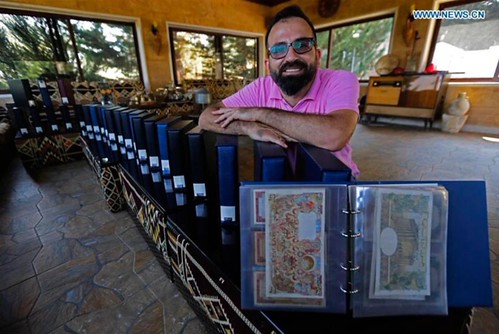
Largest banknote collection in the world?
Wissam Ali Youssef shows his collection of banknotes on October 12, 2019 at his home in Chakra, Lebanon. The 42-year-old Lebanese has recently broken a new Guinness world record because he owns the largest collection of 12,282 banknotes from various countries and regions in the world.
So was reported on October 23, 2019 on xinhuanet.com. But is his collection really the largest in the world? Of course, this is not the world's largest banknote collection. I'm just worried that many collectors do not need and want such a kind of publicity.
The HVB Foundation (formerly Pick) comprises about 350,000 banknotes, Keller brought in the collection of the Bundesbank at the time 195,000 notes. The Münzkabinett Berlin has around 90,000 notes and there is a private collector in Munich, who owns about 400,000 notes.
The Guinness Book noted records in banknote collections about 20 years ago that were not. That is probably also right to the level of nonsensical records between the largest cake and the longest sausage.
To read the complete article, see:
Größte Banknotensammlung der Welt?
(https://www.geldscheine-online.com/post/gr%C3%B6%C3%9Fte-banknotensammlung-der-welt)
To read the earlier E-Sylum article, see:
GUINNESS RECORD: LARGEST BANKNOTE COLLECTION (https://www.coinbooks.org/v22/esylum_v22n41a27.html)
LOOSE CHANGE: OCTOBER 27, 2019
Here are some additional items in the media this week that may be of interest. -Editor
CoinWeek Interviews Numismatist Editor Barbara Gregory
CoinWeek's Charles Morgan interviews Numismatist Editor Barbara Gregory in this podcast. I listened to this earlier this week - check it out. -Editor
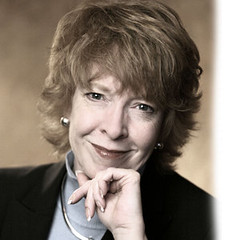 Barbara Gregory, the longtime editor of the
American Numismatic Association's (ANA) Numismatist magazine joins us to talk about the hobby's "publication of record" and how its stories impact the market. If you
haven't heard, Gregory plans to step down next year after a long and successful run.
Barbara Gregory, the longtime editor of the
American Numismatic Association's (ANA) Numismatist magazine joins us to talk about the hobby's "publication of record" and how its stories impact the market. If you
haven't heard, Gregory plans to step down next year after a long and successful run.
We discuss favorite articles and experiences while she was at the helm, and how a new initiative might bring the voice of the ANA to a brand new market.
To listen to the podcast, see:
CoinWeek Podcast #121: Numismatist Editor Barbara
Gregory (https://coinweek.com/dealers-companies/pcgs-dealers-companies/coinweek-podcast-121-numismatist-editor-barbara-gregory/)
The Subway Employee's Counterfeit Money
Most counterfeiters spend their fakes at stores to get merchandise and change. This Texas Subway sandwich artist put them in the till. -Editor
A College Station woman has been arrested after being accused of passing counterfeit money at her place of employment.
Kashirra Offing, 21, is charged with forgery. Offing was turned in to police by one of her bosses at a local Subway restaurant. Officers assigned to the case said they watched surveillance video and are using it as evidence.
Investigators said after reviewing the surveillance video evidence, Offing is seen creating a pretend transaction and removing what looks like cash bills from her bra. Offing then puts the bills under the cash register, waits to open the drawer, then swaps the fake bills with real ones, according to court documents.
Investigators examined the bills and later found them to be counterfeit, they said. One of the bills had the word "copy" printed in two places on the front and "this is not legal tender for all debts, public and private" in another location.
To read the complete article, see:
Former Subway sandwich artist
accused of swapping bills with counterfeit ones in cash register
(https://www.kagstv.com/article/news/local/college-station-woman-accused-counterfeit-bills-subway/499-ef5ccf94-4fca-4717-a8b4-09a8b98c43b4)
THE 10 SCARIEST BANKNOTES OF ALL TIME
For Halloween Kavan Ratnatunga passed along this article on the "10 Scariest Banknotes of All Time". Thanks. Here's an excerpt - see the complete article online. -Editor
#10: 100 Serbian Dinar banknote - Nikola Tesla's spooky pigeon
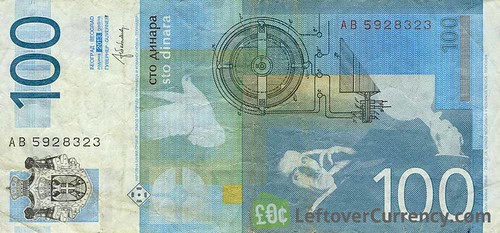
Number 10 in the list of scariest banknotes: The 100 dinara banknote from Serbia. This note features the famous and mysterious inventor Nikola Tesla, who designed the first hydroelectric plant and became the inspiration for Elon Musk's Tesla car brand. Tesla had an intense fondness for pigeons and was said to love pigeons more than people. Tesla's favorite pigeon is pictured on the banknote's back side.
In his biography, Tesla told how, one night, his favorite pigeon flew in through the window and Tesla realised that she had something important to tell him: She was dying. Tesla describes the moment that will haunt him for the rest of his life:
"There came a light from her eyes – powerful beams of light. Yes, it was a real light, a powerful, dazzling, blinding light, a light more intense than I had ever produced by the most powerful lamps in my laboratory".
#8: 200 Faroese Kronur banknote - Tindhólmur ghost island
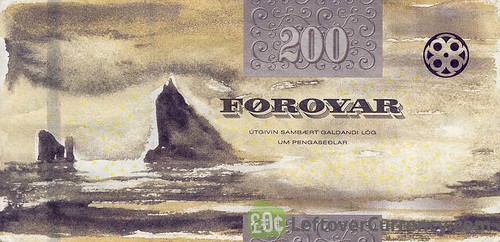
This banknote of 200 kronur from the Faroer Islands (part of Denmark) features ghosts on both sides: On the front side is the image of a ghost moth: known for its ghostlike hovering display flight, slowly rising and falling, like a phantom. In folklore, ghost moths are believed to be the souls of the departed.
Number eight on our list of scariest banknotes, the back side of the 200 Faroese Kronur note features the uninhabited islet of Tindhólmur. The small island has a local legend that explains why it became uninhabited:
"A local farmer and his family used to live on the island. But one day everything changed. A huge eagle came and took the farmer's two-year-old child and flew with it to the bird's nest on the highest peak of the islet. The mother of the child hurried up to the peak but was too late. The young of the eagle had already eaten the eyes of the child. This peak is called ‘Ørnatindur' meaning "Peak of the Eagle".
The peak of the eagle is visible on the 200 kronur banknote: It's the highest peak on the rocky island of Tindhólmur. The ghost island is open to visitors, but they are warned to keep their eyes peeled…
#4: 50 Austrian Schilling banknote - A horrible way to die
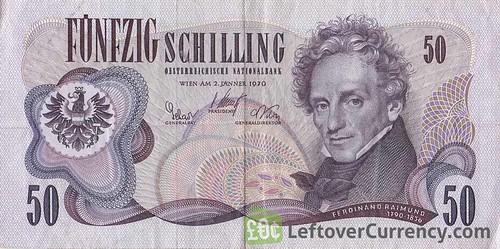
You may wonder what is so scary about the 50 Austrian Schilling banknote with the portrait of Ferdinand Raimund, actor and dramatist born in Vienna in 1790.
We selected this bill as the 4th scariest banknote because of the horrible way this poor gentleman died.
Aged 46, Ferdinand Raimund was bitten by a wild dog. Although the flesh wound was gory, it didn't kill him. However, Raimund believed the dog to be rabid. Rabies is a horrible viral disease that causes extremely painful inflammation of the brain, violent movements and death within three months.
Raimund decided to take matters into his own hands. He took a rifle and shot himself in the mouth. The bullet bounced off the inside of his skull and deflected, missing his brains. Ferdinand Raimund lived on for another 5 days, tormented by the painful gunshot wound in his head, after which he died from his injuries.
After Raimund died it turned out the dog was not rabid.
#2: 75 pfennig OberammerGau German Notgeld - Bubonic Plague
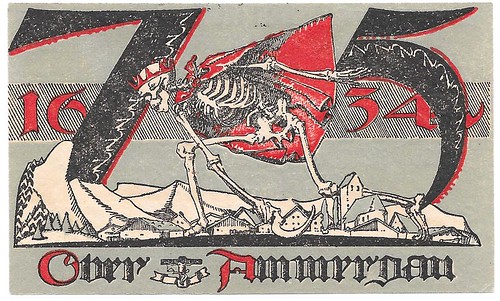
German ‘Notgeld‘ is scary on its own already: During the 1920's the German economy was in crisis and inflation was sky high. Many cities and towns started issuing their own 'emergency money', ‘Notgeld' in German.
These banknotes, or in fact ‘vouchers', were not backed by gold or deposits and they often lost their value shortly after they were issued.
The design of these emergency banknotes often gives away that they were issued during times of economic and political crisis. Such as this banknote of 75 pfennig (3/4 mark) issued by the town of Oberammergau in the Bavarian Alps, featuring: Bubonic Plague…
A giant Grim Reaper is featured mowing the town with a scythe. The year printed on the banknote, 1634, is when the bubonic plague death rate finally went down. The villagers vowed that if God spared them from the plague, they would produce a Passion Play every 10 years depicting the life and death of Jesus. The first Oberammergau Passion Play was performed in 1634 and it is still being performed in the present day, every 10 years, most recently in 2010.
Jesus on the cross is depicted on the note as well, below the Grim Reaper, referring to the Passion Play performed in the town since it was saved from the Bubonic Plague. This grim Notgeld bill is number two in our list of scariest banknotes.
To read the complete article, see:
10 Scariest Banknotes of All Time (https://www.leftovercurrency.com/scariest-banknotes/)
FEATURED WEB PAGE: MODERN HALLOWEEN COINS
This week's Featured Web Page is an October 11, 2018 Coin Update article on skulls and other Halloween themes on modern coins. Happy Halloween!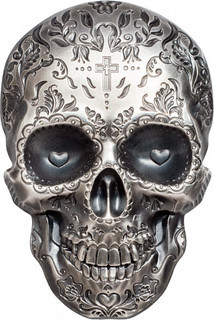
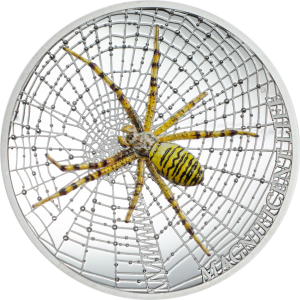
https://news.coinupdate.com/of-skulls-and-
deaths-head-hawkmoths-on-coins-how-halloween-
became-successful-in-the-german-speaking-world/

